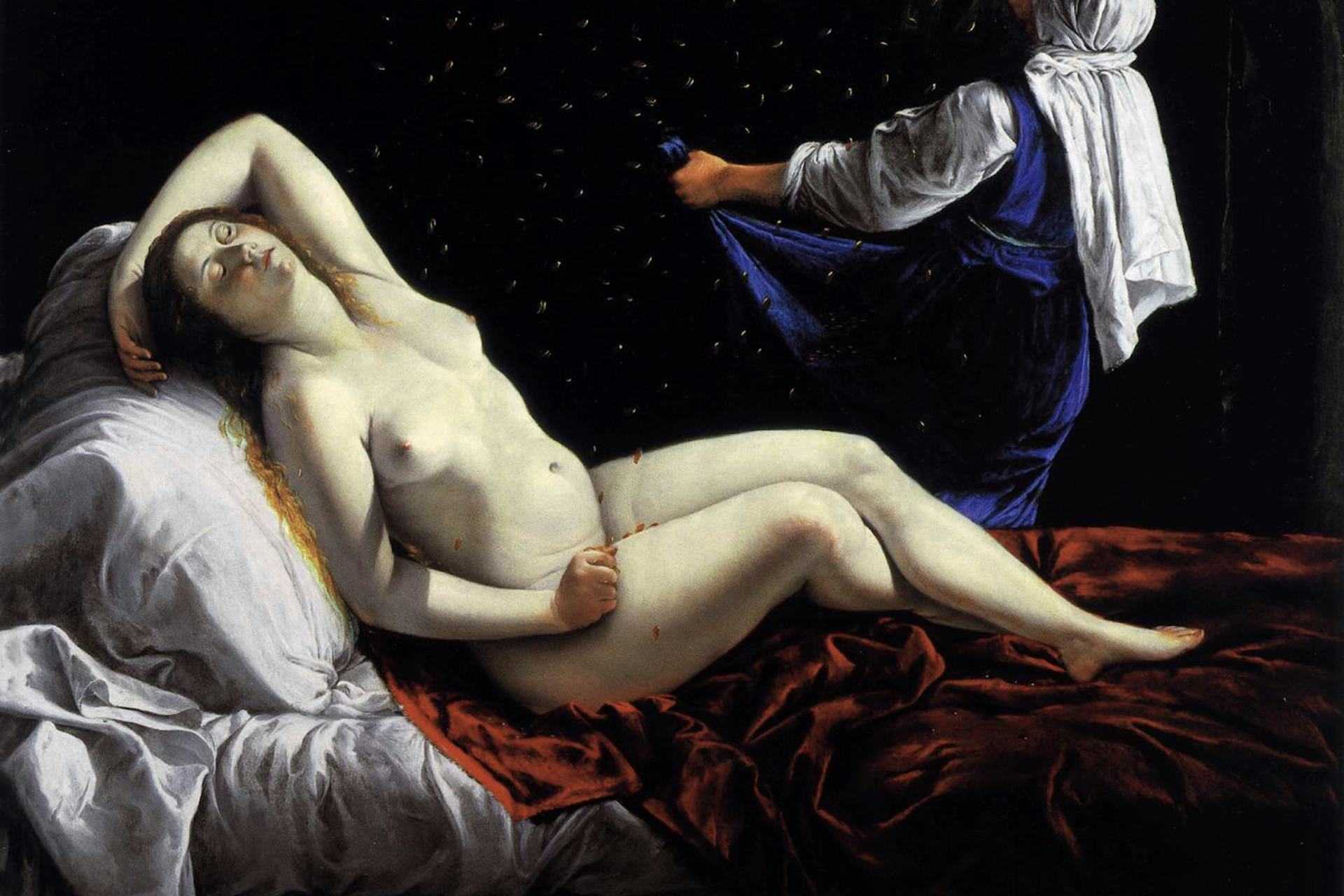
Danae by Artemisia Gentileschi (ca. 1612)
Perseus, son of Zeus and the Argive princess Danae , was a Greek hero and king connected with the Argolid. Perseus’ numerous exploits included beheading Medusa , saving the princess Andromeda , and founding the city of Mycenae and the Perseid dynasty.
Banished from Argos before he was born (due to an ominous prophecy), Perseus grew up on a remote island. When he came of age, he was sent to kill the Gorgon Medusa, a monster whose gaze turned all who looked upon her to stone. Later, while passing through Ethiopia, Perseus rescued the princess Andromeda from a sea monster and made her his wife.
At the end of his adventures, Perseus became the ruler of Mycenae and founded the important dynasty of the “Perseids.” The Greeks of the Argolid revered Perseus as one of their most important ancestral heroes.

Who were Perseus’ parents?
Perseus was the son of Zeus, the king of the gods, and Danae, a mortal princess and daughter of the Argive king Acrisius.
Danae’s father was told by an oracle that he was destined to die at the hands of his grandson. Thus, he locked Danae up in a dungeon to prevent her from ever bearing a son. But Zeus visited Danae as a shower of gold dust, and Perseus was conceived from their union.
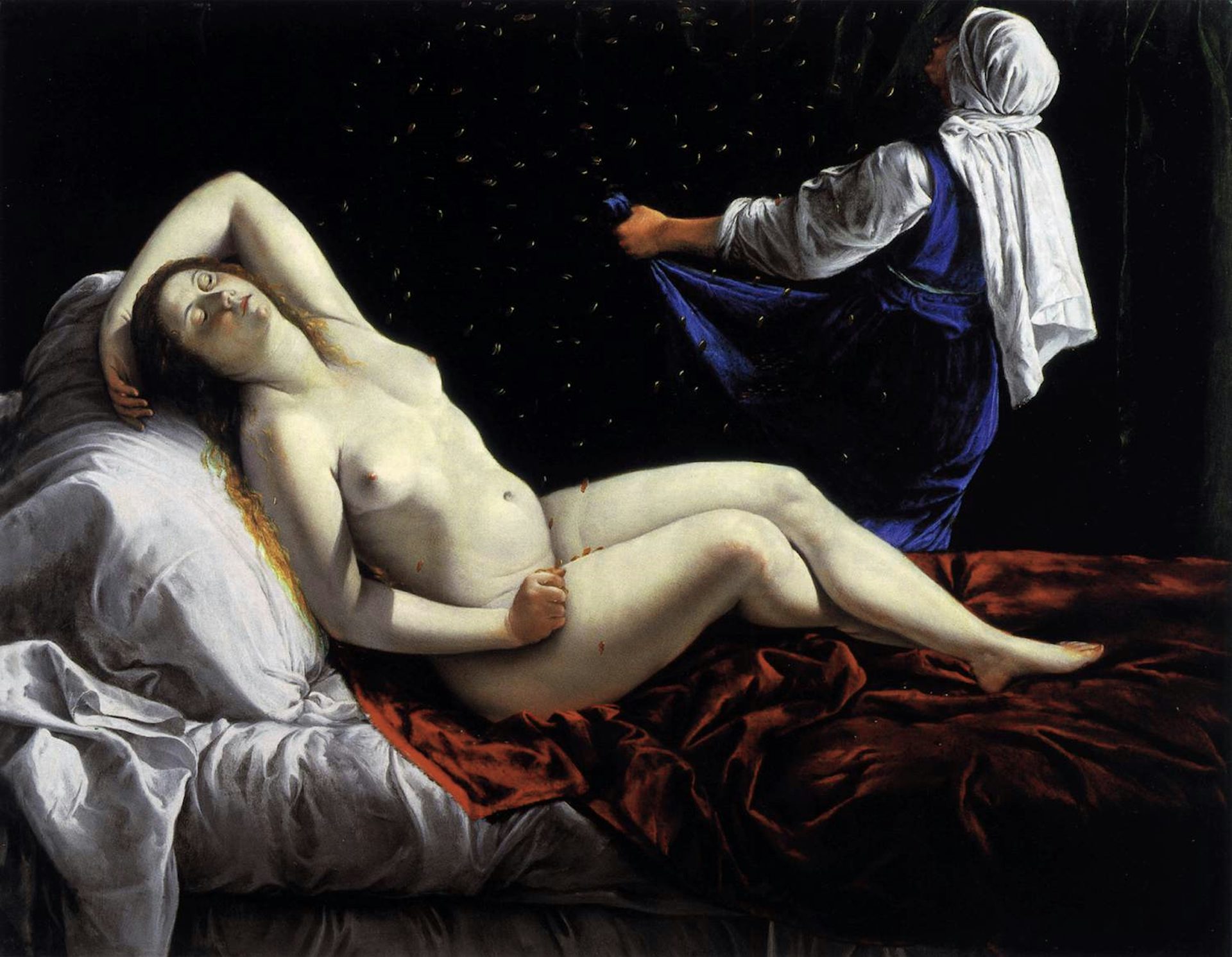
Where did Perseus live?
Perseus was conceived, and perhaps born, in Argos, the homeland of his mother Danae. But when his grandfather Acrisius discovered that Danae had become pregnant despite his precautions, he locked her and her child in a chest and threw it into the sea. The chest floated safely to the island of Seriphos, where the mother and son were taken in by a kindly fisherman.
Years later, after accomplishing various heroic feats, Perseus returned to the Argolid to reclaim his birthright. He became king of Mycenae (or Tiryns, in some versions), establishing the great mythical dynasty of the Perseids.
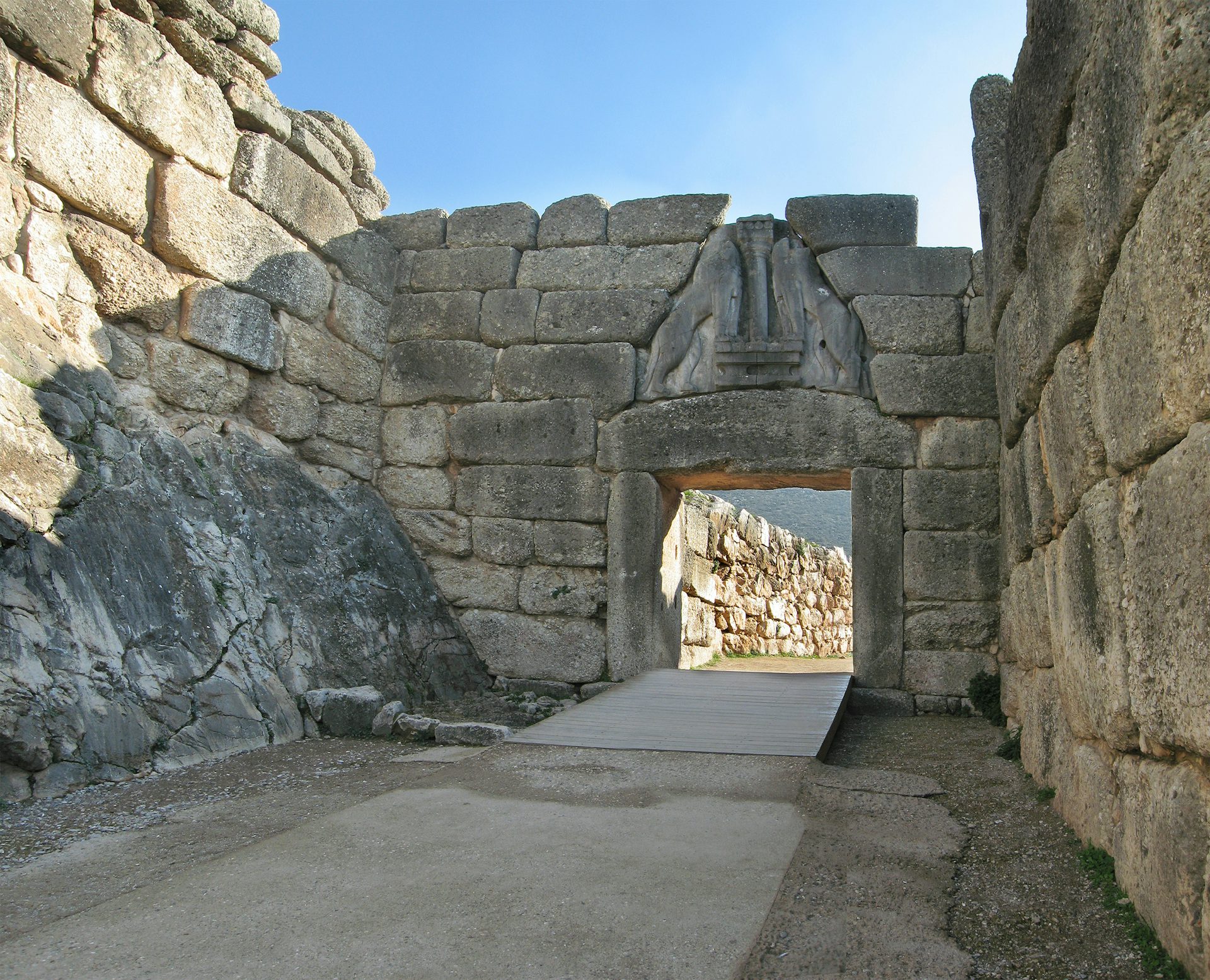
A photo of the Lions Gate in Mycenae
Who was Perseus’ wife?
Perseus married Andromeda, an Eastern princess. Andromeda’s mother, Cassiopeia , had offended the sea gods by boasting of her own beauty; as punishment for this arrogance, she was made to sacrifice her daughter to the gods. Andromeda was thus chained to a cliff on the seashore to be devoured by a sea monster sent by Poseidon .
Perseus happened to be passing by at this time. Seeing the beautiful girl chained to a rock, he killed the sea monster and returned her to her parents. In gratitude, Cassiopeia and her husband Cepheus gave Andromeda to Perseus in marriage.
Perseus and Andromeda soon traveled to Greece, where they had many children. They are remembered as the ancestors of a number of great heroes, including Heracles .
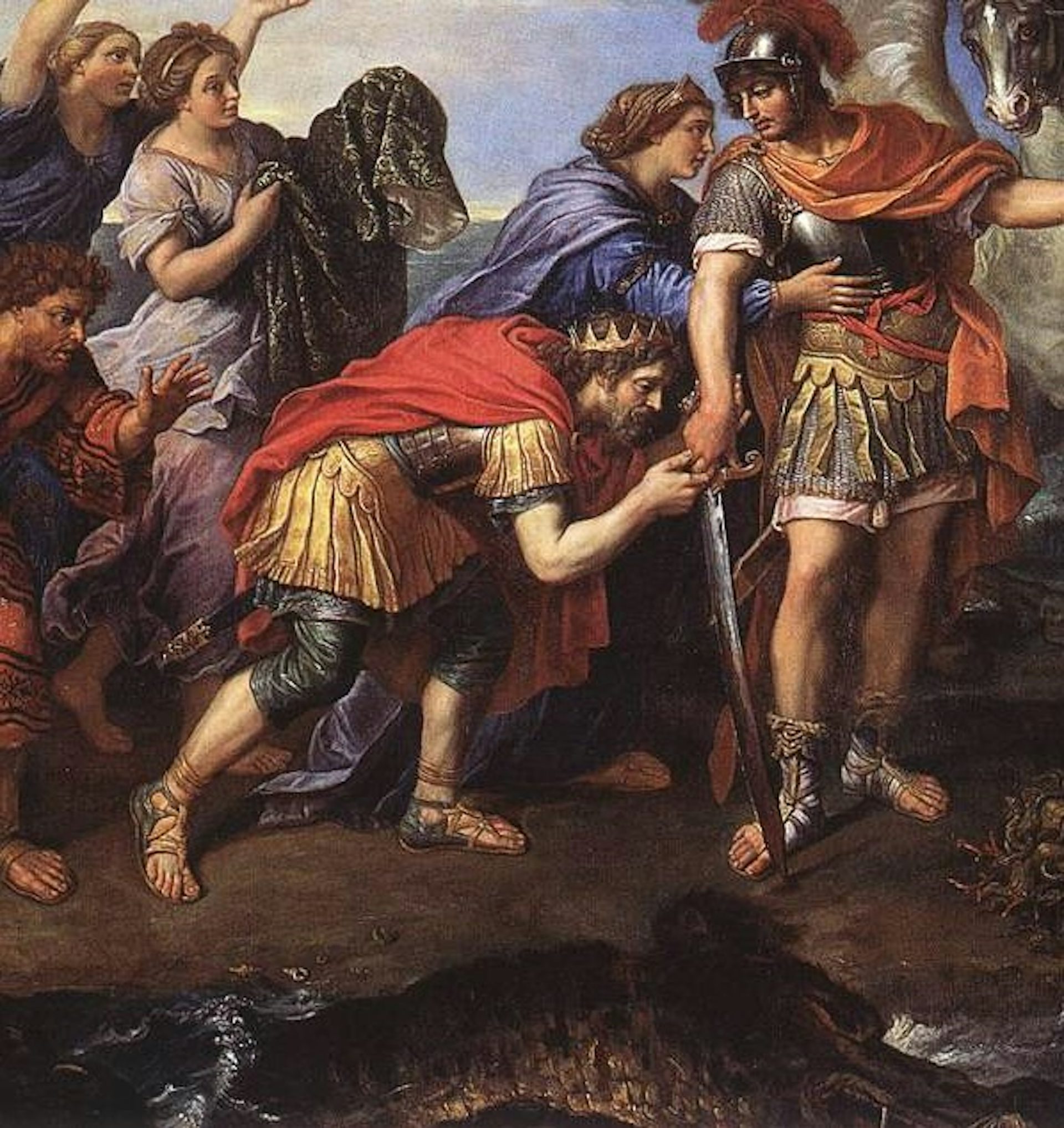
Detail from Perseus and Andromeda by Pierre Mignard I (1679). Cepheus is depicted kissing the hand of Perseus after he rescues his daughter Andromeda.
Perseus Slays Medusa
Perseus was sent to kill Medusa by Polydectes, the king of Seriphos (Polydectes wanted the young man out of the picture so he could marry his mother Danae). The king thought that Perseus would be killed on his mission, since Medusa was a terrible Gorgon whose gaze turned people to stone.
But Perseus had considerable help from the gods, who gave him the tools he would need to fight Medusa: an adamant sickle, a mirror-polished shield, winged sandals, Hades ’ helmet of invisibility, and a special satchel to contain the Gorgon’s head. Thus armed, Perseus beheaded the monster and brought the terrible head back to Polydectes—who turned to stone as soon as he looked at it.
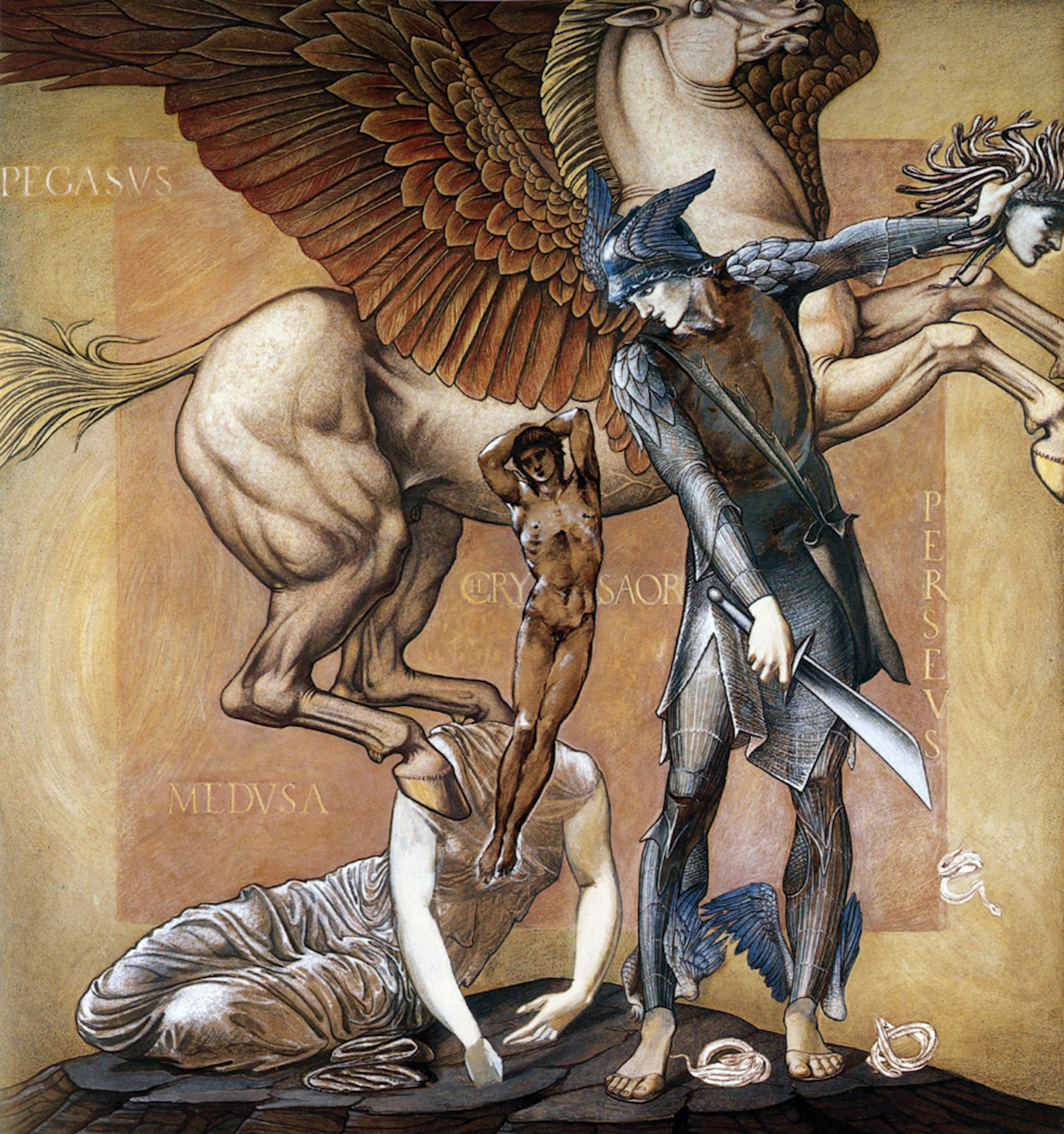
The Death of Medusa I by Edward Burne-Jones (1882)
The etymology of Perseus’ name is obscure. An ancient folk etymology connected the name “Perseus” with the Persians, as he was sometimes said to have been their ancestor. [1]
Scholars in the eighteenth and nineteenth centuries often believed the name was derived from the Greek verb πέρθειν ( perthein , "to sack, destroy"), combined with the ending -eus, which is common in many early Greek names ( Theseus , Prometheus , etc.): Perseus’ name is thus translated as “the destroyer.” [2]
Other scholars have suggested that his name is connected with the underworld goddess Persephone [3] or even with the Hittite war god Pirwa. [4]
Experts also disagree on when the name and its bearer originated. Martin Nilsson confidently dated Perseus and his myths to the Bronze Age (ca. 1600–1100 BCE), [5] while T. P. Howe has argued that the name and the hero were invented later, perhaps during the Archaic Period (ca. 800–490 BCE). [6]
Pronunciation
An early hero and a famous slayer of monsters, Perseus was usually represented with the weapons and artifacts he received from the gods to fight Medusa: an unbreakable sword, a helmet of invisibility, a mirror shield, winged sandals, and a magic satchel. In ancient and modern iconography, he is often shown holding the head of Medusa, which he wielded to turn his enemies to stone.
Following his exploits, Perseus built the city of Mycenae. Located in central Greece (in the northeast corner of the Peloponnese), this was one of the most important cities in Greek mythology. Perseus’ name became associated with the powerful Perseid dynasty, which included not only many Mycenaean kings but also famous heroes such as Heracles.
Perseus was a son of Zeus, the ruler of the Greek gods. [7] His mother was Danae, the daughter of Acrisius, king of Argos. On his mother’s side, this made Perseus a descendant of the first ruling dynasty of Argos, which traced its origin to the river god Inachus.
With his wife Andromeda, Perseus had many children. According to Apollodorus, Perseus had six sons (Perses, Alcaeus, Sthenelus, Heleus, Mestor, and Electryon) [8] and one daughter (Gorgophone). [9]
Family Tree
Like many of the children Zeus had by mortal mothers, Perseus’ early years were tumultuous and unhappy. Before Perseus was born, Acrisius, the king of Argos, was warned that he would one day be killed by his grandson. Acrisius therefore imprisoned his only child, Danae, to prevent her from ever having a son.
But Zeus fell in love with the beautiful Danae and visited her as a shower of gold dust. Soon after, Danae gave birth to Perseus. [10]
Acrisius, still fearful of the prophecy that he would be killed by his grandson, locked Danae and the baby Perseus in a chest, which he threw into the sea. The chest floated across the sea for many days until it finally washed ashore on the island of Seriphos.
There, Danae and Perseus were found by Dictys, a fisherman and the brother of the king of the island, Polydectes. The kindly Dictys took in Danae and helped her raise Perseus.
When Perseus had grown to manhood, Polydectes, the king of Seriphos, fell in love with Danae. Danae, however, did not wish to marry Polydectes, and Perseus protected his mother from Polydectes’ unwanted advances. Polydectes then began plotting to get rid of Perseus.
One day, Polydectes held a large banquet at which each guest was ordered to bring him a gift. Of Perseus, Polydectes demanded the head of Medusa. This was regarded as a nearly impossible task: Medusa was one of the three monsters known as the Gorgons, whose heads were ringed by snakes instead of hair and whose gaze turned people to stone. Not shrinking from the daunting task, Perseus promised to bring Polydectes the head of Medusa.
In his quest for Medusa, Perseus was guided by the goddess Athena , the daughter of Zeus and thus his divine half-sister. Athena explained to him that only the Hesperides , the maidens guarding the grove of Hera , could tell him where to find Medusa and the Gorgons. But first, Perseus needed to find the Hesperides.
Instructed by Athena, Perseus visited the Graiae , the sisters of the Gorgons, to learn the whereabouts of the Hesperides. The Graiae were three old women who shared a single eye between them. Perseus sneaked up on the Graiae and snatched away their one eye, which he agreed to give back only after they told him where to find the Hesperides.
When Perseus reached the Hesperides, he was given a special satchel that could safely carry Medusa’s head. The other gods also helped supply Perseus for his quest: from Athena, he received a shield with a polished face; from his father, Zeus, he received an unbreakable sickle; from Hades , he received a helmet that rendered him invisible; finally, from Hermes , he received winged sandals.
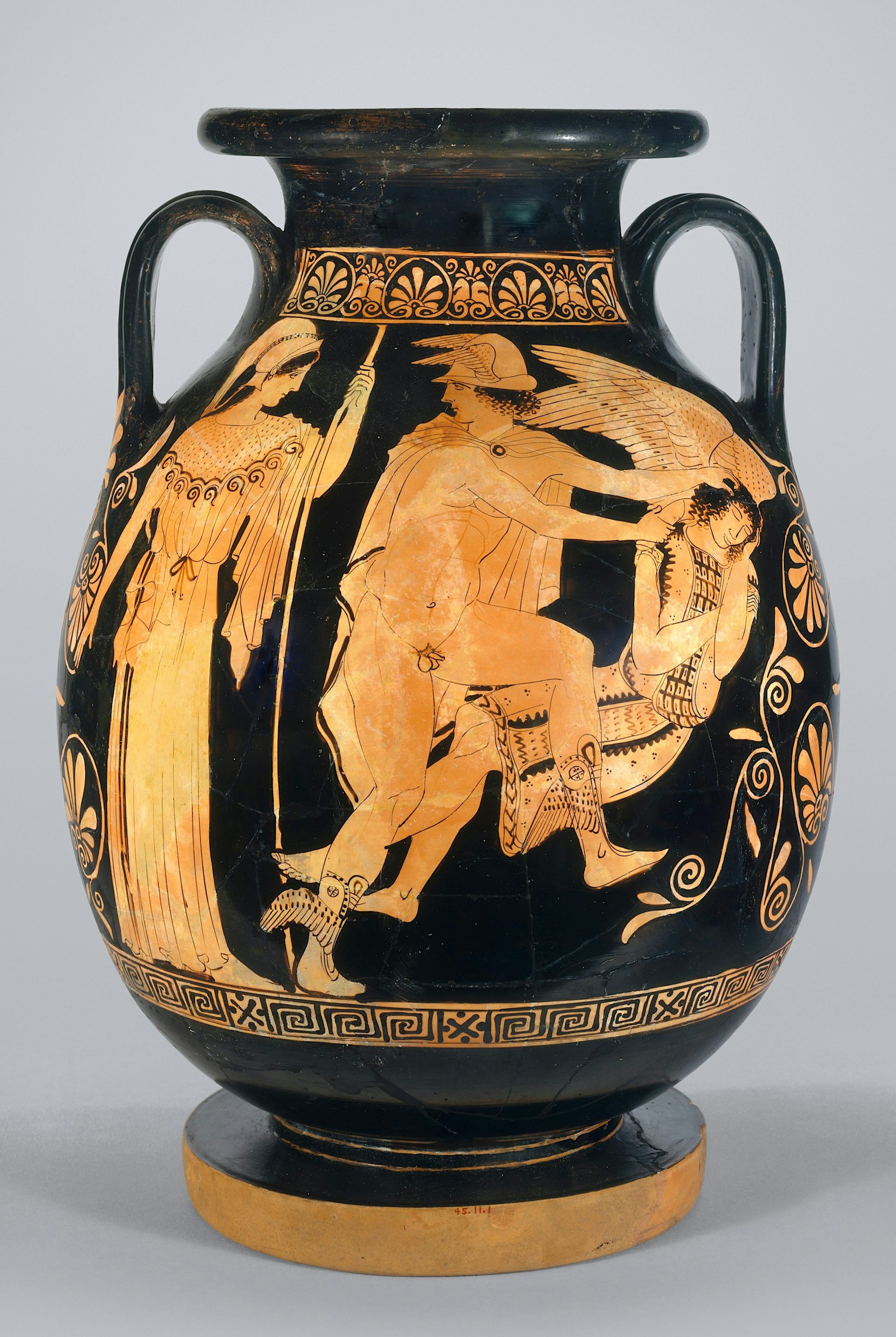
Vase painting showing Perseus beheading a sleeping Medusa, attributed to Polygnotus (450–440 BCE). Perseus looks to Athena and away from Medusa to avoid turning into stone.
Thus equipped, Perseus went to the cave of the Gorgons. When he found Medusa, he was able to approach her without turning to stone by looking at her reflection in Athena’s shield. He then cut off Medusa’s head using Zeus’ sword. When Medusa’s blood spilled to the earth, the winged horse Pegasus and his brother Chrysaor were born. Using Hades’ helmet of invisibility, Perseus snatched away Medusa’s severed head and escaped.
As Perseus made his way home, he passed through Ethiopia. There, he witnessed a strange and terrible scene: a beautiful young girl was bound naked to a rock, waiting for a sea monster to emerge from the depths and devour her. Cassiopeia, the queen of Ethiopia, had boasted that she was more beautiful than the fifty daughters of the sea deity Nereus . [11] This angered Poseidon, who brought destruction on Ethiopia and would only be appeased if Cassiopeia sacrificed her daughter Andromeda to him. Andromeda was thus left in chains at the sea’s edge for Poseidon’s sea monster Cetus.
This was the scene that was unfolding as Perseus arrived in Ethiopia. Approaching Cassiopeia and her husband Cepheus, the king of Ethiopia, Perseus offered to save Andromeda’s life in exchange for her hand in marriage. Cassiopeia and Cepheus agreed (though no version of the myth explains why they abandoned their plans for sacrifice). Perseus subsequently killed Cetus and set Andromeda free.
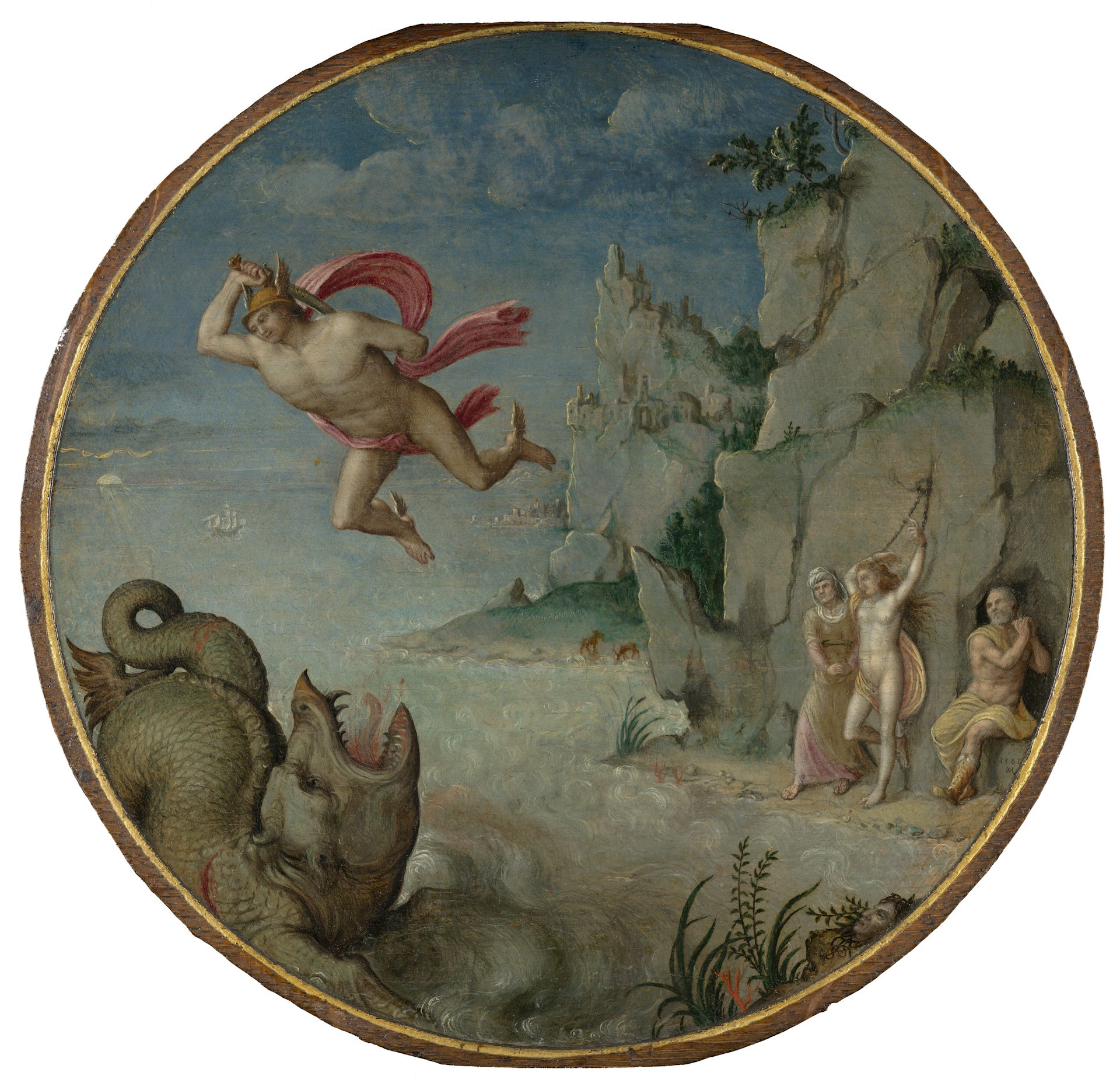
Perseus and Andromeda by Jan Keynooghe (1561).
The wedding of Perseus and Andromeda was disturbed, however, by the arrival of her uncle Phineus, who had originally been engaged to Andromeda. A quarrel erupted. In the end, Perseus turned Phineus and his supporters to stone by displaying Medusa’s head.
Perseus finally came back to Seriphos with his new bride, only to find that Polydectes had continued to pursue his mother, Danae. Perseus decided to end Polydectes’ unwanted advances once and for all. Going to Polydectes’ palace, Perseus showed the lecherous king the “gift” he himself had requested: the head of Medusa. Polydectes, disbelieving, looked at the Gorgon’s head and turned to stone.

The Wedding of Perseus Interrupted by Phineus by Hugues Taraval (1767)
After setting up Dictys as king of Seriphos in place of his brother Polydectes, Perseus returned to Argos, the kingdom of his grandfather Acrisius. When Acrisius learned of Perseus’ return, however, he fled the city, still dreading the prophecy that had predicted he would be killed by his grandson.
While Perseus was taking part in athletic games in the city of Larissa, he threw a discus, which struck an old man in the audience and killed him immediately. Later it was discovered that the victim was none other than his grandfather, Acrisius, thus inadvertently fulfilling the prophecy. Saddened, Perseus buried his grandfather and gave the kingdom of Argos to his cousin Megapenthes.
The House of Perseus
According to many traditions, Perseus then ascended the throne of Tiryns and founded the city of Mycenae. [12] He would become famous for building the formidable walls of Mycenae, made of boulders fitted tightly together without mortar. These fortifications, which are still standing today, were called “Cyclopean” in antiquity because they looked like they could only have been built by the giant Cyclopes .
Perseus founded the powerful House of Perseus, which supplied generations of kings and heroes. Through the children he had with Andromeda, Perseus became the ancestor of many important people, including the Persians, Heracles, Helen of Troy , and the Dioscuri ( Castor and Polydeuces ).
Perseus was sometimes worshipped as a hero in ancient Greece. The earliest evidence of his cult has been found in Mycenae: an inscription from the late sixth century BCE mentions “priestly analysts” of Perseus (an obscure term probably referring to record-keepers who also performed religious functions). [13]
Pausanias, a geographer who lived in the second century CE, wrote that in his own time the most important sanctuaries to Perseus were in Seriphos and Athens. He also described an altar to the hero on the road from Mycenae to Argos. [14] However, these cults do not seem to have existed before the Hellenistic Period (323–31 BCE). Aside from these scraps, little is known of the hero worship associated with Perseus.
Pop Culture
The myth of Perseus does appear in contemporary popular culture, even if Perseus is not as familiar as some other Greek mythical figures (such as Heracles). The 1981 film Clash of the Titans (remade in 2010) is loosely adapted from the myth of Perseus. Percy Jackson, the main character of Rick Riordan’s book series Percy Jackson and the Olympians , is named after Perseus.
In his modern portrayals, Perseus is generally a rather one-dimensional hero: brave, chivalrous, determined, noble. This is more or less in line with Perseus’ representation in ancient myth, where he was chiefly motivated by a desire to defend the weak (his mother, Andromeda) and never shrank from even the most daunting tasks.
Greek Gods & Goddesses
One of the oldest out of all of the Greek mythological heroes.
He is best known in Greek mythology as the slayer of Medusa, one of three female creatures, or Gorgons , with hair said to be made of poisonous snakes.
Perseus and his origins on Argos
Perseus was thought to exist several generations before the famous Heracles (Hercules). He was born to Danae, his mother, who was a mortal (meaning that she was not a God). Danae was the daughter of the king of Argos, King Acrisius. King Acrisius had once sought advice from the oracle at Delphi because he had been unable to have a son. In Greek mythology, oracles were like fortune tellers and Acrisius was seeking information for his future. The oracle told King Acrisius that he would one day be killed by his daughter’s son.
King Acrisius was determined to keep that from happening, so he decided to lock up his only daughter, Danae. According to the legend, she was imprisoned in a bronze enclosure (some versions of the story say that it was a tall bronze tower, other versions report that it was actually an underground prison that was open to the sky). His goal was to keep her from male suitors so that she could not become pregnant.
The myth goes on to say that through the opening in her enclosure, the great God Zeus came to her in a golden rainfall. From that meeting with the very amorous Zeus, Danae did become pregnant and had a child while still imprisoned. That child was the legendary Perseus. Thus, Perseus was known as a demigod , meaning that he was born of both mortal (his mother, Danae) and immortal (his father, Zeus) parents. When King Acrisius realized that his daughter had, in fact, had a child, he feared for his life, but was unable to take the lives of his daughter and grandson. Instead, he responded by locking Danae and Perseus in a wooden chest and casting them out to sea.
Perseus on the Island of Seriphos
Perseus and his mother, Danae experienced calm seas after being cast out of Argos. The legends say that Zeus played a role in that by speaking to Poseidon, the God of the sea , so that they may have a calm journey. Eventually, Danae and Perseus washed up onto the shores of the island of Seriphos, an Aegean island. There, they were found by a fisherman called Diktys. He proceeded to help raise Perseus on the island of Seriphos.
Perseus spent many years at Seriphos. He was known there as a young man with great physical strength as well as great courage. Danae stayed there as well. She happened to catch the eye of the brother of Diktys, who was also the King of the island. His name was King Polydectes. The King wished to court Danae, but Perseus did not want that for his mother and he therefore became an obstacle for the king.
King Polydectes needed a way to rid himself of Perseus so that he could get to Danae. Perseus was eventually overheard boasting about his physical strength, saying that he could single-handedly kill the dreaded Gorgon Medusa. This was the opportunity that King Polydectes was looking for. He presented a challenge to Perseus that if he could not make good on his boast to kill Medusa, then the King would take possession of his mother.
Perseus and the Graiai
With the challenge from King Polydectes, Perseus was started on a mission to slay the Gorgon Medusa. Medusa was one of the three Gorgons, sisters who were known for their hair made of venomous snakes and who could turn men to stone with just a single look. Medusa was the only one of the Gorgons who was mortal (meaning that she could be killed).
Perseus first consulted the Gods, who advised him to seek out the Graiai. The Graiai were actually 3 other sisters of the Gorgons. The myth states that the Graiai were three old witches who had only one tooth and one eye between them. Perseus was said to have stolen the eye and would only return it for information on finding Medusa and also information on finding the cap of Hades (a cap that made the person invisible when he wore it) as well as winged sandals to enable him to fly. He also asked for the kibisis, a special bag that he would use to carry the head of Medusa.
In order to get their eye back, the Graiai gave in and helped Perseus to find the items he asked for. With those items as well as a sickle given to him by the God Hermes , Perseus was on his way to attempt to slay Medusa.
Perseus and Medusa
The Gorgon Medusa , along with her sisters Sthenno and Euryale, were said to live at the ends of the Earth beyond the oceans. Perseus was able to fly to their lair thanks to his flying sandals that he now had.
Using the cap of Hades to render him invisible, he was able to find and silently slay Medusa with the sickle that he received from Hermes. In addition to killing Medusa, this event was said to be the birth event of Pegasus , the mythological winged horse, and his brother Chrysaor , who were said to have emerged from the severed neck of Medusa.
Upon slaying Medusa, the other Gorgon sisters were alerted and tried to subdue Perseus. However, the God Athena assisted Perseus with fleeing and he was able to escape with the head of Medusa in the kibisis.
Perseus and Andromeda
Perseus was triumphant in his quest to kill the Gorgon Medusa. While on his journey back to the Island of Seriphos where his mother awaited, he came across the beautiful Andromeda. The legends say that Andromeda was the daughter of Cepheus and Cassiopeia , who were the king and the queen of Ethiopia.
Cassiopeia had bragged about Andromeda’s beauty, saying that she was more beautiful than the Nereids. The Nereids were sea nymphs, or female spirits of the sea. Poseidon, being the God of the sea, was angered by the boasting of Cassiopeia. Out of his anger, Poseidon sent a great flood to Ethiopia. He also sent a sea monster to wreak havoc on the territory. It was said that the only way to appease Poseidon was to offer up Andromeda as a sacrifice to the sea monster, and so that was done. Andromeda was kept chained to a rock by the sea monster, which is where she was first seen by Perseus as he journeyed back from Medusa’s lair.
Perseus immediately fell in love with Andromeda. In order to marry her, he offered a trade to Cepheus, the King. He would slay the sea monster that was terrorizing the kingdom and in return would take Andromeda’s hand in marriage. The king accepted the deal. Perseus easily slayed the sea monster using the weapon that he carried in his kibisis: the slain head of the Gorgon Medusa. One look at Medusa and the sea monster was turned to stone. The head of Medusa also brought about another casualty.
Phineus, who was the brother of King Cepheus, also wanted to marry Andromeda and claimed that she had been promised to him. He decided to claim Andromeda for himself and stood in the way of her union with Perseus. Perseus again used Medusa’s head to defeat his competition, turning Phineus to stone just as he did the sea monster.
Return to Seriphos
After his victorious defeat of Medusa and his marriage to Andromeda, Perseus continued back to Seriphos where his mother awaited. Upon his return, he quickly learned that King Polydectes had been abusive to his mother Danae while he was away on his quest.
Infuriated, Perseus brought the head of Medusa to the king, but instead of just giving the severed head to Polydectes, he again used it as a weapon against his foe. Showing the king the head of Medusa gave him the same fate as Poseidon’s sea monster and Phineus. This, in turn, made Diktys, the fisherman who raised Perseus, the new king since he was the brother of Polydectes.
Finally, Perseus would be rid of Medusa’s head when he presented it as a gift to the God Athena .
Perseus and the Oracle’s Prophecy
The myths say that Perseus eventually returned to Argos with Danae and Andromeda. King Acrisius had gone to Larissa in Greece, probably to avoid Perseus. However, Perseus went to Larissa in search of his grandfather.
Perseus was, of course, known as a great athlete with tremendous strength. Upon arriving at Larissa, he found that there were funeral games being held there. He joined in the games and participated in a discus throwing event. As fate would have it, Perseus threw a discus which went off track and into the crowd. The discus hit and immediately killed King Acrisius, thus fulfilling the prophecy of the oracle at Delphi so many years before this event.
Perseus, King of Mycenae
After causing the prophesized death of his grandfather Acrisius, Perseus was noted to be ashamed to take the kingdom for his own. Instead, he offered the kingdom of Argos to Megapenthes who was his uncle and the ruler of Tiryns. In exchange, Perseus would become the ruler of Tiryns.
From there, it is said that Perseus went on to form the Kingdom of Mycenae. The legends vary on this part of his life, just as there are variations to the other stories of his life. A popular story is that he did take up residence there as King along with Andromeda. After years of ruling over the kingdom of Mycenae, he died of old age.
Since he was a loyal servant to the Greek mythological Gods, he was placed in the skies among the skies along with Andromeda and Cassiopeia and has remained there forever.
Facts About Perseus
In Greek mythology, various old texts are used as references along with centuries old artifacts and drawings. Many variations of the old stories have been told. For example, in one version of the story of Perseus, the oracle’s prophecy was fulfilled when Perseus showed Medusa’s head to Acrisius to prove that he had actually slain her. This, of course, would have killed Acrisius and still fulfilled the prophecy.
There are variations in the other stories of Perseus, as well as in all of Greek mythology. Since there are differing texts and stories, it is important to note the parts of the legends that are fairly consistent. Those are noted here for a “quick facts” reference:
• Perseus was the son of Danae and had a mortal father, Danaos, but was believed to actually be the son of Danae and Zeus. • Perseus was one of the oldest of the Greek heroes , predating Heracles (Hercules) by three generations. • Since Zeus was thought to have fathered both Perseus and Heracles, that made Perseus the great grandfather of Heracles . . . but also his half-brother! • King Acrisius was afraid of his fate because an oracle said he would be killed at the hands of his future grandson (which would turn out to be Perseus). • To prevent having a grandson, Perseus imprisoned his own daughter, Danae in a bronze enclosure (either a tower or an underground enclosure). • The God Zeus fathered Perseus when he had relations with Danae even though she was locked away. • King Acrisius sent Danae and Perseus away at sea locked in a chest out of fear for the oracle’s prophecy. • Perseus was raised by a fisherman, Diktys, on the island of Seriphos, where he was eventually challenged by the King of Seriphos to slay the Gorgon Medusa. • Perseus stole the eye of the three Graiai in order to convince them to give the location of Medusa as well as items used to slay her: the invisibility cap of Hades, the kibisis to carry her head, and winged sandals to enable him to fly. • After killing the Gorgon Medusa and escaping from her two immortal sisters, he found Andromeda on the journey back. • He eventually wed Andromeda after rescuing her and slaying Poseidon’s sea monster. He also had to kill Phineus, another suitor of Andromeda, in the process. • Upon returning to Seriphos, Perseus found out that his mother, Danae, was forced to hide from the King of Seriphos because of his abuse of her. Perseus presented Medusa’s head to him, killing him with her stare. This resulted in Diktys, the fisherman who raised Perseus, becoming the new king. • Although there are differing stories as to how it happens, the oracle’s prophecy is eventually fulfilled by the death of King Acrisius at the hands of Perseus after he returns to Argos and then to Larissa, either by accidentally striking him with a discus or by showing him Medusa’s head to prove that he had slain her. • Perseus eventually reigns over Mycenae with Andromeda and dies of old age (at least in one version of the myth)! • Perseus has been falsely associated as being a rider of Pegasus, the winged horse. It was a Greek hero, Bellerophon , who tamed and used Pegasus in battle. The association of Perseus with Pegasus involves the beheading of Medusa which set forth the first appearance of Pegasus.
Link/cite this page
If you use any of the content on this page in your own work, please use the code below to cite this page as the source of the content.
Link will appear as Perseus: https://greekgodsandgoddesses.net - Greek Gods & Goddesses, February 11, 2017
History Cooperative
Perseus: The Argive Hero of Greek Mythology
Perseus was the Argive king and a famous Greek hero. A fellow child of Zeus, Perseus famously beheaded the snake-haired Medusa, fought a sea monster for Andromeda, and accidentally killed his grandfather while playing sports.
Table of Contents
Who Was Perseus?
Perseus was a legendary hero in Greek mythology known for his daring exploits and heroic deeds. He was the son of Zeus, the king of the gods, and Danaë, a mortal princess and is often remembered for fulfilling a prophecy about him, but even more so for his quest to slay the Gorgon Medusa and rescue Princess Andromeda whom he later married and together they had many children.
Perseus’ adventures and lineage have been a source of inspiration for countless works of art, literature, and culture throughout history. His story embodies the themes of heroism, destiny, and the interplay between mortals and gods in ancient Greek mythology.
Is Perseus the Son of Zeus or Poseidon?
Due to his connection to the sea, many think that Perseus is related to Poseidon . But Perseus is, without a doubt, the son of the king of the gods, Zeus . No source of mythology states that Poseidon was his father, although the sea god does play a role in Perseus’ story. Rather than the father of Perseus, Poseidon is a lover of Medusa , a sea monster who Perseus slew. There is no evidence that Poseidon was angry about this action, however, and the god appears to play no other role in the story of the Grecian hero.
Who Was the Mother of Perseus?
Perseus was the child of Danae, a princess of Argos. More importantly, he was the grandson of Acrisius and Eurydice. The story of Perseus’ birth and the prophecy of his grandfather’s death would become the center of the myth known as “The Golden Shower.”
What is the Story of the Golden Shower?
Danae was the firstborn child of King Acrisius, and he was concerned that he would not have a son to take over his kingdom. Acrisius spoke to the Oracles, who prophesied that the son of Danae would be the cause of the old king’s death.
Frightened by this prophecy, Acrisius imprisoned his daughter in a bronze chamber and buried her underground. According to Pseudo-Apollodorus , the king of the gods became a golden rain and seeped into the cracks of the chamber. “Zeus had intercourse with her in the shape of a stream of gold which poured through the roof into Danae’s lap.”
Enraged that she was to fall pregnant, and believing that it was Proteus, not Zeus, that had gotten into the chamber, Acrisius dragged Danae back out of the chamber. He shut her up in a chest with Perseus and cast it into the sea. Pseudo-Hyginus states, “By Jove’s [Zeus’] will, it was borne to the island of Seriphos, and when the fisherman Dictys found it and broke it open, he discovered the mother and child. He took them to King Polydectes [his brother], who married Danae and brought up Perseus in the temple of Minerva [ Athena ].”
Perseus and Medusa
The most famous story of Perseus is his quest to kill the famous monster, Medusa. Any man who saw her face would turn to stone, and it was considered a feat that Perseus could survive her presence, let alone kill her. Perseus only succeeded by owning special armor and weapons from the gods and later took advantage of holding Medusa’s head when confronted with the Titan Atlas .
What is a Gorgon?
Gorgons, or Gorgones, were three-winged “daimones,” or “phantoms of Hades .” Called Medousa (Medusa), Sthenmo, and Euryale, only Medusa was mortal. Some ancient Greek art would depict all three gorgons as having “serpentine hair,” tusks like pigs, and big round heads.
Euripedes and Homer each only referred to a single Gorgon, Medusa. However, those myths which mention three women call them sisters and say that the other two were punished simply because of Medusa’s transgressions. It was said that Sthenmo and Euryale tried to kill Perseus but could not find him due to the special helmet he wore, Hades’ Helmet .
Who Was Medusa?
The full story of Medusa, taking into account the oldest myths and the younger poems and stories that survived through the Roman Empire , is one of tragedy. The terrible monster beheaded by Perseus wasn’t always so horrifying or deadly.
Medusa was a beautiful young woman, a virgin priestess of the goddess Athena . She and her sisters were daughters of the primordial sea gods, Ceto and Phorcys. While her sisters were immortal gods themselves, Medusa was a mortal woman only.
Medusa had promised to keep her chastity in honor of her deity and took this vow seriously. However, according to multiple sources, she was a particularly beautiful woman and did not go unnoticed by the Greek gods . Poseidon took a special interest in her, and one day came down to Athena’s shrine and raped the poor woman. Athena was insulted that Medusa was no longer a virgin and punished her by turning her into a monster. For standing by their sibling, she did the same to the other two gorgons.
Where Did Medusa Get Her Powers?
Athena’s punishment came with great and terrible features. Medusa grew wings, tusks, and long claws. Her long, beautiful hair became a head of snakes. And anyone who looked upon the head, even after it was removed, would turn to stone. In this way, no man would ever wish to look upon the woman again.
Why Was Medusa Killed by Perseus?
Perseus had no personal grudge against Medusa. No, he was sent to kill her by King Polydectes of Seriphos. Polydectes had fallen in love with Danae. Perseus was quite protective of his mother, with all they had been through, and was cautious about the King.
While some myths suggest that Perseus volunteered to retrieve the head as a wedding gift, others say he was ordered to as a method of getting rid of the pesky young man. Either way, Perseus was known for boasting and would not shame himself by returning empty-handed.
What Objects Were Given to Perseus?
Perseus was the son of Zeus, and the god of gods wanted to protect him on his quest. So Zeus and his brothers got together armor and weapons to help Perseus succeed against Medusa. Hades gave Perseus the helmet of invisibility, Hermes his winged sandals, Hephaestus a mighty sword, and Athena a reflective bronze shield.
The Helmet of Hades
The Helmet of Hades was one of the gifts of the Cyclopes to the young Olympian gods when they first fought the Titans in the Titanomachy . At this time, Zeus was given his thunderbolts, and Poseidon his famous Trident. As such, the helmet would have been Hades’ most important object, and to offer it to Perseus was a great symbol of care of this god of the underworld for his nephew.
READ MORE: Poseidon’s Trident: A Legendary Weapon of the Sea God
The Helmet of Hades was also used by Athene in the battle of Troy and Hermes when he fought Hippolytus , the giant.
The Winged Sandals of Hermes
Hermes, the messenger of the Greek gods, wore winged sandals that let him fly at supernatural speed around the world to pass messages between gods, and also bring warnings and prophesies to mortals. Perseus is one of the few people besides Hermes to wear winged sandals.
The Sword of Hephaestus
Hephaestus, the Greek god of fire and blacksmith to the Olympians, would create armor and weapons for many heroes over the years. He made armor for Heracles and Achilles , arrows for Appolo and Artemis , and an Aigis (or goat-skin breastplate) for Zeus. No human-made weapon could pierce the armor of the great blacksmith, and only a weapon he made himself had a chance – the sword of Hephaestus. This he gave to Perseus, and it was only ever used once.
The Bronze Shield of Athena
While Athena, the goddess of women and knowledge, was often portrayed as holding a shield, the story of Perseus is the only surviving account of it being used. The bronze polished shield was quite reflective, which came in very handy. Today, many surviving bronze shields from ancient antiquity are carved with the Gorgon’s head as a warning for all who face the wielder.
How Did Perseus Kill Medusa?
The items brought by Perseus were integral to the killing of the Gorgon Medusa. By looking at the bronze shield’s reflection, he never had to gaze directly upon the monster. By wearing the winged sandals, he could move in and out quickly. One swipe of the sword and the Gorgon was beheaded, her snake-covered face quickly placed in a bag. Medusa’s siblings awoke but could not find her killer as he wore the Helm of Hades. Perseus was gone before they ever understood what had happened.
When Perseus beheaded Medusa, from the remains of her body came the winged horse, Pegasus , and Chrysaor. These children of Poseidon would go on to have their own stories in Greek mythology .
A Possible Historical Version of Medusa
Pausanias, in his Description of Greece , offers a historical version of Medusa that may be worth mentioning. In his work, he says that she was the queen of those around Lake Tritonis (modern-day Libya), and faced Perseus and his army in battle. Rather than die on the field, she was assassinated during the night. Perseus, admiring her beauty even in death, beheaded her to show the Greeks upon his return.
Another account in the same text says that Procles, a Carthaginian, believed Medusa to be a “Wild Woman” of Libya, a form of big-foot, who would harass the people in nearby towns. She was someone who would kill anyone who saw her, and the snakes were simply the curly and knotted hair that was naturally on her head.
Did Gorgons Invent Flutes?
In a strange little side-note, an interesting fact about Medusa and her sisters was integral to the invention of the flute. While the instrument itself was created by Pallas Athene, Pindar says that she “wove into music the dire dirge of the reckless Gorgons which Perseus heard” and “imitate with musical instruments the shrill cry that reached her ears from the fast-moving jaws of Euryale.” Yes, the high-pitched notes of the flute were the screams of the Gorgons as they mourned over the death of their sister.
What Happened When Perseus Returned With the Head of Medusa?
Returning to the island of Seriphos, the Greek hero discovered his mother in hiding. Polydectes had been abusing her. Perseus hunted the King down and showed him the head of the Gorgon – literally. He turned the king to stone. According to some tellings of the myth, Perseus turned all the king’s soldiers and even the entire island to stone. He handed the kingdom to Dictys, who had protected Danae from his brother.
Perseus, upon saving his mother, returned to Argos. There Perseus killed the current King, Proteus, and took his place on the throne. Proteus was the brother of Acrisius (Perseus’ grandfather) and their own war had lasted decades. For Perseus to take his place as King would be considered a good thing for many of the people of Argo. It is also said that Perseus built the towns of Mideia and Mycenae, and fought to stop the Dionysian mysteries.
Perseus and Atlas
According to Ovid , as Perseus traveled back to Polydectes, he stopped in the lands of Atlas . The fields of Atlas contained the golden fruit, some of which the old Titan had previously given to Heracles. However, Atlas also remembered the sayings of an Oracle, as told by Themis .
READ MORE: The Oracle of Delphi: The Ancient Greek Fortuneteller
“O Atlas,” the oracle said, “mark the day a son of Zeus shall come to spoil; for when thy trees been stripped of golden fruit, the glory shall be his.” Worried that this son was Perseus, Atlas was always careful. He had built a wall around his fields, and protected them with a dragon. When Perseus sought a place to rest, Atlas refused him. For this insult, Perseus showed the severed head of Medusa, and the old Titan turned to stone. To this day, the god can be seen as Mount Atlas.
Of this, Ovid said, “Now his hair and beard were changed into trees, his shoulders and hands into ridges. What had been his head before was the crest on the mountain summit. His bones became stones. Then he grew to an immense height in every part (so you gods determined) and the whole sky, with its many stars, rested on him.”
How Did Perseus Save Andromeda from the Sea Monster?
Ovid’s Metamorphoses tells the story of how Perseus, traveling back from killing the Gorgon, came across the beautiful Ethiopian, Andromeda, and saved her from a vicious sea monster ( Cetus ).
Perseus had been traveling home from slaying Medusa when he came across a beautiful woman by the sea. Andromeda had been left chained to a rock as a sacrifice to a sea monster. Andromeda’s mother boasted that she was more beautiful than the Nereids, so Poseidon sent the monster to attack the city. The oracles of Zeus told the King that, by sacrificing Andromeda, the monster would be appeased and go once more.
Just as Andromeda had told Perseus her tale, the monster rose from the waters. Perseus made a deal – if he dealt with the monster, Andromeda would become his wife. Her parents agreed. Perseus flew into the air like an ancient superhero, drew his sword, and dived at the creature. He stabbed it multiple times, in the neck and back, and attacked every time the creature rose to the surface. Eventually, it died.
Unfortunately for the city’s people, the celebrations did not last long. Phineus, brother of the king and uncle to Andromeda, had been promised the beautiful maiden as his wife. Angry at Perseus (instead of the gods that wished her to be sacrificed) he took up arms and started a great fight. It ended with Perseus taking the Gorgon’s head from its bag and turning the entire Ethiopian army into stone.
Perseus took the beautiful woman with him back to Argos. There, he married Andromeda, and she would live to old age, giving Perseus many children. When she eventually died, Athena took her body into the sky and made her a constellation.
Perseus Against Dionysus
It isn’t one hundred percent clear if Perseus was against the worship of Dionysus ; mythology texts say that the King of Argos was, but some versions mean Proteus. In the versions that name Perseus, the story is grim. It is said that the priestesses of Chorea, women who followed Dionysus, were slaughtered by Perseus and his followers and dumped into a communal grave.
The best-known story of Perseus and Dionysus comes from Nonnus , who wrote an entire biography of the bacchic god. In book 47 of the text, Perseus kills Ariadne by turning her into stone, while a disguised Hera warns the hero that, to win, he would also need to kill all the Satyrs . Dionysus could not be turned to stone, however. He owned a giant diamond, “the gem made stone in the showers of Zeus,” which prevented the magic of Medusa’s head.
Dionysus, in his rage, might very well have leveled Argos and killed Perseus if it wasn’t for Hermes. The messenger god stepped in.
“It is not Perseus’ fault,” Hermes told Dionysus, “but Hera , who convinced him to fight. Blame Hera. As for Ariadne, be happy. All die, but few get to die at the hands of a hero. Now she is in heaven with the other great women, like Elektra, my mother Maia, and your mother Semele.”
Dionysus calmed and let Perseus live. Perseus, realizing he had been tricked by Hera, changed his ways and supported the Dionysian mysteries. According to Pausanias, “they say that the god, having made war on Perseus, afterward laid aside his enmity, and received great honors at the hands of the Argives, including this precinct set specially apart for himself.”
Why Did Perseus Kill His Grandfather?
Unfortunately for Acrisius, the oracle’s prophesy eventually came true. Perseus was eventually the person to kill his grandfather. However, instead of it being in battle or any form of murder, death came only as an accident.
Whether it is Pausanius or Apollodorus you read, the story is remarkably the same. Perseus was attending sporting games (either for competition or part of funeral celebrations), where he was playing “quoits” (or discus throw). Acrisius, not knowing his grandson was present and not being careful as a spectator, was struck by one of these discs and died instantly. Thus the prophecy was fulfilled, and Perseus was officially the rightful claim to the throne of Argos. In some stories, it was only then that he went and killed Proteus, but the chronology is different throughout history.
Who Kills Perseus?
Perseus was eventually killed by Megapenthes, son of Proetus. It is said he was killed because of the death of Proetus. Both Proetus and Megapenthes were Kings of Argos, and Magapenthes was the cousin of Danae.
According to another tale , Perseus lived to old age, founding the city of Tartus and teaching the magi of Persia. Eventually, he turned the head of Medusa upon himself and turned to stone. His son, Merros, then burned the head so that it could never be used again.
What are 3 Trivia Facts about Perseus?
Perseus is the only hero to wear items from four separate gods.
While Hermes used the helm of Hades, and many heroes wore the armor of Hephaestus, no other character in Greek mythology obtained that many accouterments from different gods.
Through Mortal Bloodlines, Perseus was the Great-Grandfather of Helen of Troy
Gorgophone, daughter of Perseus, was to give birth to Tyndareus. He would then marry the princess, Leda. While it was Zeus that fathered Helen and Pollux by sleeping with Leda while in the form of a Swan, Tyndareus was considered their mortal father.
Perseus Never Rode Pegasus
Despite releasing the winged horse when he killed Medusa, no ancient mythology has Perseus ever riding Pegasus. The other Greek hero, Bellerophon , tamed the magical beast. However, classical and Renaissance artists loved depicting the creature being ridden by the better-known hero, so the two myths are often confused.
What Do We Know about Historical Perseus?
While much was written about the Perseus legend, modern historians and archeologists have been unable to uncover anything about the real Argive king. Both Herodotus and Pausanias wrote passages about what they could discover about this king, including his possible connections in Egypt and Persia. In Herodotus’ Histories, we learn the most about the mortal Perseus, his possible family, and the role his heritage might have played in ancient wars.
Herodotus names Perseus as the son of Danae but points out that it is unknown who his father may have been – this is compared to Heracles, whose father was Amphitryon. Herodotus points out that Assyrians believed Perseus to have been from Persia, hence the similar name. He would become a Greek, rather than be born one. Modern linguists, however, dismiss this etymology as a coincidence. However, the same text says that Danae’s father, Acrisius, was of Egyptian stock, so Perseus may have been the first Greek in the family through both lines.
Herodotus also records that when Xerxes, the Persian king, came to conquer Greece, he attempted to convince the people of Argos that he was the descendent of Perseus, and, therefore their rightful king already.
In Egypt, there was a city called Khemmis, which Herodotus records had a temple to Perseus:
“The people of this Khemmis say that Perseus is seen often up and down this land, and often within the temple and that the sandal he wears, which is four feet long, keeps turning up and that when it does turn up, all Egypt prospers. This is what they say, and their doings in honor of Perseus are Greek, inasmuch as they celebrate games that include every form of contest, and offer animals and cloaks and skins as prizes. When I asked why Perseus appeared only to them, and why, unlike all other Egyptians, they celebrate games, they told me that Perseus was by the lineage of their city.”
How is Perseus Portrayed in Art?
Perseus was often represented in ancient times in the act of removing Medusa’s head. In Pompeii, a fresco shows an infant Perseus, holding aloft the Gorgon’s head, and this pose is replicated in statues and artwork around Greece. Some vases have also been found that depict the story of the golden shower , in which Danae is locked away.
In later times, Artists would paint quite detailed works of Perseus holding the head of Medusa, and they would inform similar beheadings, such as David and Goliath, or the beheading of John the Baptist. Artists of the Renaissance, including Titian, were also interested in the story of Perseus and Andromeda, and this subject gained popularity once again in the mid-19th century.
Who is Perseus Jackson?
Perseus “Percy” Jackson, is the main character of a popular YA book series called “Percy Jackson and the Olympians.” Written by Rick Riordan, the series of books follows a modern story of a demi-god fighting to stop the “Titans” from taking over the world. While the books are filled with characters and tropes from Greek mythology, they are original tales set in modern times. “Percy” trains as a god at “Camp Half-Blood” and travels America on adventures. This series is often compared to the British “Harry Potter” series, and the first book was adapted into a film in 2010.
How is Perseus Otherwise Portrayed in Modern Culture?
While the name “Perseus” has been given to a number of ships, mountains, and even early computers , the Greek hero doesn’t have the same name recognition today as Heracles/Hercules. It is only those interested in the stars that may see the name appear commonly, and that is because there is a very famous constellation named after the Argive king.
Where is the Perseus Constellation?
The Perseus Constellation was cataloged in the 2nd century by the Greek astronomer Ptolemy and has been the source of great study ever since. It is bordered by Taurus and Ares to the south, Andromeda to the west, Cassiopeia to the north, and Auriga to the east. The best-known star within the constellation is Algol, Horus, or Beta Persei. In ancient Greek astronomy, it represented the head of Medusa. Interestingly, in all other cultures, including Hebrew and Arabic, it is a head (sometimes “Ras Al-gol” or “demon’s head”). This star is approximately 92 light years from Earth.
It is from the Perseus Constellation that we also see the Perseid Meteor Shower, which has been documented since 36 AD. This phenomenon can be viewed yearly in early August and is the result of the path of the Swift-Tuttle Comet.
How to Cite this Article
There are three different ways you can cite this article.
1. To cite this article in an academic-style article or paper , use:
<a href=" https://historycooperative.org/perseus/ ">Perseus: The Argive Hero of Greek Mythology</a>
Leave a Comment Cancel reply

MythologySource

- What Were the Hamadryads in Greek Mythology?
- The Hades and Persephone Story
- Was the Griffin a Bird from Greek Mythology?
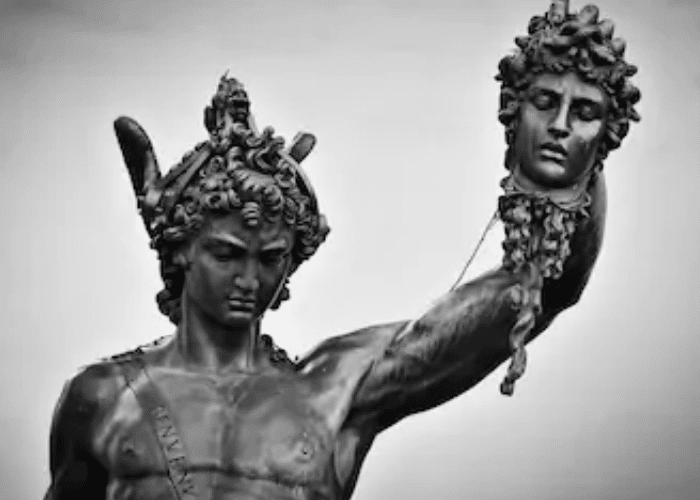
Perseus: The Hero Who Killed the Gorgon
If all you know about Perseus is that he killed Medusa, be prepared to be shocked by the full story of one of Greece’s most famous heroes!
Perseus is one of the great heroes of ancient Greek mythology. Like Theseus or Heracles, his name is familiar to most people even if they don’t know all the details of his story.
Also like them, Perseus was a semi-divine man who was a favorite of the gods.
His most well-known exploit was the slaying of Medusa, the monster that could turn men to stone just by looking at them. With help, stealth, and trickery he was able to destroy the monster that most believed to be un-killable.
But there is much more to the story of Perseus than just his quest to fetch the Gorgon’s head .
His birth story stands out as one of the most magical and fantastic, even compared to the other affairs of Zeus . He was cast away to die as a baby, but miraculously survived and grew into a powerful, heroic man.
He had one of the few happy and successful marriages in Greek mythology and went on to be the ancestor of many of the most important names and kingdoms of legend.
From his magical conception to his rule as king, keep reading to learn all about Perseus, one of the great heroes of the ancient Greek world!
The Birth of Perseus
Like many of the great heroes of Greek mythology, Perseus was a son of Zeus. And, like many, he was born to a human mother.
His mother Danaë was the daughter of Acrisius, the king of Argos. At the time, Argos was one of the most prosperous cities of Greece, situated on the fertile plain in a good strategic location.
Acrisius had a twin brother, Proteus , with whom he had quarreled his entire life. The two were so at odds that it was said they had fought each other constantly even while in their mother’s womb.
After the death of their father, the two had fought over his kingdom. Acrisius had expelled his brother, but Proteus returned with reinforcements from his in-laws.
Acrisius had been forced to compromise with his brother and split the kingdom. He retained control of Argos while Proteus was given control over Tiryns, a city that was less important at the time.
Danaë was known as a great beauty, but the king took little joy from her. She was his only child, a fact which threatened his control over Argos.
The king had no sons and was worried about his lack of an heir. He consulted an oracle to learn whether he would ever have a son to carry on his dynasty.
Instead, the oracle delivered disturbing news. She said that Acrisius would not have a son, but that he would be killed by the son of Danaë.
The king was determined to keep his daughter from ever having a child who would lead to his death. He locked her in a bronze chamber, forbidding anyone to come into contact with her.
Some versions of the story say that the chamber was built underground in the courtyard of the palace of Argos. Others claimed that the princess was shut away in a tower made entirely of bronze.
Acrisius had taken precautions against allowing men to have access to the princess, but he had failed to take the gods into account. Danaë’s prison was open to the sky.
Zeus soon noticed the beautiful maiden locked away in the courtyard and decided to make her his next mistress.
Zeus came to Danaë in a shower of golden rain. Nine months later she gave birth to his son, Perseus.
Acrisius feared the prediction made by the oracle more than ever. He also refused to believe his daughter’s story that she had been visited by Zeus in a magical form.
Paranoid and angry, he shut both his daughter and grandson in a wooden chest and set them adrift at sea. He could not risk angering the gods by killing his own family members, but he assumed they would die in the open waters.
Acrisius, believing he had avoided the oracle’s prophecy by sending his child and grandchild to their deaths, resigned himself to the fact that Proteus would become his heir.
Danaë, meanwhile, saw little chance of escape for herself and her newborn. The box was nailed shut so she could do nothing but drift blindly in the dark and pray to the gods for mercy.
Luckily for them, Zeus was looking out for his newborn son . Their box ran aground on the island of Seriphos.
They were found by Dictys, who was a fisherman and the brother of the island’s king. He took them in and raised Perseus as if he were his own son.
As the years passed and Perseus grew to manhood, Danaë remained beautiful. The king, Polydectes, decided he would make her his wife.
Perseus, however, was very protective of his mother. He did not trust the king, who could often be arrogant and demanding.
To marry Danaë, Polydectes would need to remove Perseus as an obstacle. But, as he would learn, it was not always easy to get rid of a son of Zeus .
The Quest for the Gorgon’s Head
The king devised a plan to rid himself of Perseus so that he could marry Danaë without opposition.
He told his court that he was marrying another woman and asked the men, including Perseus, to bring him suitable gifts. He asked for horses from the others, but trapped Danaë’s son with a boast.
When asked what he was willing to give the king, the young man said that he would bring him anything he wanted, even the head of the Gorgon. Polydectes decided to ask for just that.
Medusa, the Gorgon, was a terrifying monster who lived with her sisters in a cave at the edge of the world. All three were vicious and deadly, but Medusa was particularly terrible.
She had snakes for hair and the power to turn men to stone with a single look.
She was also the only one of the three sisters that was mortal, giving a sliver of hope to Perseus on his quest.
Polydectes was certain that the mission would kill the brash young man.
Perseus, too, was uncertain of his success. He did not even know where to find the Gorgons, let alone how he would manage to kill the most deadly of them.
As Zeus’s son, though he was given help.
Athena appeared to her half-brother and advised him to seek out the Hesperides. These nymphs were in the service of Hera and, according to Athena, had gifts that would enable the young hero to complete his quest.
Their garden, however, was also hidden. Perseus first had to seek out the Greae.
These three sisters of the Gorgons also lived together. They shared one eye and one tooth between them, taking turns to look out over the world and to eat.
Their cave was easier to find than his other objectives, and Perseus knew that with their powerful and ever-watchful eye the Greae would know how he could find the Hesperides’ garden.
He hid in the shadows, taking care to remain still and quiet so the sisters would not know he was there. At the moment they passed the eye between each other, he dashed out and stole it from them.
Perseus told the three old women that he would give them back their eye if they told him how to reach the Hesperides.
They did, but the legends differ on how Perseus responded. Some said he returned the eye and left peacefully, others said he threw it into the ocean and left the Greae blinded.
With their directions, though, he was able to find his way to the Hesperides. Just as Athena had said, the nymphs had great gifts to help him in his quest.
First, the Hesperides presented him with a knapsack that could safely contain the monster’s head. Then his divine family arrived to lend their aid as well.
Athena gave him the use of her polished shield. His half-brother Hermes allowed the hero to borrow his winged sandals.
Zeus himself had gifts as well. He lent his son a sword made of adamantine and his brother Hades’ helmet that granted invisibility to the wearer.
Now armed by the gods, Perseus was ready to slay the Gorgon.
He crept into the monsters’ lair while they were asleep. He held the shield of Athena before him so that, by not looking directly at Medusa, he could find his way without the risk of being turned to stone.
Using the adamantine sword, he cut the monster’s head off in a single stroke.
He stuffed the head into the knapsack and put on the helmet of invisibility. When Medusa’s sisters awoke, they could not see the killer among them.
Infuriated, the remaining Gorgons began to claw wildly at the air. Using the sandals of Hermes gave Perseus the speed to evade their grasping hands and flee the cave before they could find him.
Perseus and Andromeda
With his quest completed, the only thing left for Perseus to do was to present the gift to Polydectes.
According to some stories, he found a use for the Gorgon’s head along the way. He passed the Titan Prometheus , who had been bound eternally for going against Zeus, and turned him to stone.
As he flew above the Libyan desert, blood dripped from the knapsack that held Medusa’s head. Wherever a drop fell, a viper came to life in the sand.
These were not the only children born of Medusa’s blood. When she was beheaded, she had given birth to Chrysaor and the famous winged horse Pegasus .
His next great adventure, however, began when he arrived at the kingdom of Aethiopia.
Queen Cassiopeia had offended Poseidon when she claimed that her daughter, Andromeda, was more beautiful than the Nereids. To avenge the insult, Poseidon had sent a terrible sea monster against the Aethiopians.
The god of the sea had flooded Aethiopia so his monster, a Cetus, could cause more destruction. Desperate to save his country, King Cepheus consulted the Oracle of Ammon.
He was told that no relief would come to his lands until he exposed Andromeda to be eaten by the sea serpent. Perseus arrived to find the princess chained to a rock on the shore.
When Perseus saw her it was love at first sight, and he promised to kill the Ketos (Sea-Monster) and rescue the girl in return for her hand. Oaths were sworn, after which Perseus faced and slew the monster, and set Andromeda free. Kepheus’ brother Phineus, who was previously engaged to Andromeda, conspired against Perseus, but Perseus learned of the plot, and by displaying the Gorgo [Medusa’s head] to Phineus and his colleagues in the conspiracy, turned them instantly to stone. -Pseudo-Apollodorus, Bibliotheca 2. 43 – 44 (trans. Aldrich)
Perseus had freed the princess both from the sea monster and from marriage to her uncle. The two were married at once and returned to Seriphos.
When they arrived, Perseus learned that his mother had gone into hiding. When he had left, Polydectes had made his intentions clear and had attempted to violently abduct Danaë and force her to marry him.
The king was also planning to have Perseus murdered in the event that he did return from his quest.
Furious, Perseus stormed into the king’s palace. He announced that he had retrieved the gift asked of him and pulled Medusa’s head from the knapsack.
The wicked king was turned to stone the moment he looked at it. Perseus had saved his mother at last.
Dictys became king in his brother’s place, and was a much better ruler. The new king, who had always been a father figure to Perseus, also married Danaë with both her consent and her son’s blessing.
Children and Dynasties
Unlike many gods and heroes, Perseus enjoyed a happy marriage with Andromeda. They had seven sons and two daughters together.
These children were responsible for more than just a few minor stories, though. Through his nine children, Perseus became the ancestor to many of the most celebrated heroes of Greece and several lines of kingship.
Their children were:
- Perses – He remained in Libya and became the founder of the first ruling dynasty of Persia.
- Alcaeus – His son, Amphitryon, was the stepfather of Heracles.
- Sthenelus – He became king of Mycenae.
- Mestor – His grandson founded the island city of Taphos. By the time of the Trojan War it was part of Odysseus’s kingdom of Ithaca.
- Electryon – The king of Tiryns after his father, his daughter Alcmene was the mother of Heracles.
- Gorgophone – The queen of Sparta, she was said to have been the first woman to ever marry twice. Her son Tyndareus married Leda and was the moral father of her children – Helen of Troy, Clytemnestra, Castor, and Pollux.
- Autochthe – She was one of the many wives of King Aegeus of Athens whom he divorced because they could not give him male heirs.
- Cynurus – He founded the city of Cynurus in southeastern Greece.
- Heleus – The town of Helos was said to have been founded by him.
The children were collectively known as the Perseids.
Through their many children, Perseus and Andromeda became the ancestors of some of Greece’s most notable individuals.
Perseus the King
Perseus and Andromeda did not stay on the island of Seriphos to raise their family, though.
First, they paid a visit to Athena. Perseus returned the gifts the gods had lent him and presented the Gorgon’s head to the goddess who had aided him.
Athena mounted the head on her shield, where it became one of her defining attributes.
The couple then went to Thessaly, where the king of Larissa was holding funeral games in his father’s honor.
Perseus did not know his grandfather, Acrisius, was also in attendance. He had not seen the king since he was an infant and did not recognize him.
While they were both competing in the discus throw, Perseus’s throw veered off trajectory. It struck the king of Argos in the head, killing him.
The oracle’s prophesy had been fulfilled and Acrisius had been killed by Danaë’s son, albeit accidentally.
Perseus was, under the law, now the heir to his grandfather’s kingdom. He felt guilt, however, at the way in which he had gained the throne.
Although it had been an accident, the killing of a family member was a major sin to an upright prince like Perseus. He could not stomach the idea of taking power for himself under such circumstances.
Tradition also stated that anyone who killed a countryman, even if it was accidentally, had to be exiled from that land until they were purified and had atoned for the crime. Even though he was the heir, Perseus could not rightfully take his place as king.
A compromise was reached when Perseus reached out to his cousin, Magapenthes. The son of Proteus, Magapenthes had been next in line when Argos had lacked a more direct heir to the throne.
They came to an agreement that the two would trade kingdoms. Instead of ruling Argos, Perseus became the king of Tiryns.
Magapenthes was more than happy with this arrangement, as his family had sought Argos for many years. Tiryns was a less celebrated city, but Perseus thought it was a fair trade-off to avoid angering the gods and violating the natural law.
Perseus and Andromeda settled in the Mycenaean city where he became a successful and well-loved king.
The Historical King
To the Greeks, Perseus was not a figure from mythology. They believed he was a real, historical king who ruled Mycenae in the distant past.
They believed that the hero was central in founding Greek culture. When he took over Tiryns, it was a small city-state with little political importance.
Perseus built his new kingdom into Mycenae, a kingdom that dominated Bronze Age Greece. The culture of the entire eastern Mediterranean region in the 2nd millennium BC is referred to as Mycenaean because of the state’s importance in culture and trade.
In establishing Mycenae as a major power, Perseus also became an ancestor to everyone who shared Greek culture. The Mycenaeans established much of the art, mythology, philosophy , and law that would come to define all of Greece.
Perseus was not just an ancestor to more heroes and kings than most other figures in Greek mythology , but as a founder of Mycenae he was a spiritual ancestor to all Greek people.
Perseus the Hero of Mycenae
Perseus is remembered as one of the most famous heroes in Greek mythology.
The Greeks themselves were fond of him. Although he never ascended to become a god, he was still revered at shrines in the ancient world as a venerated ancestor.
As a son of Zeus and a favorite of Athena, his name became associated with the gods even if he was not one of them. Unlike many other heroes, not one of the Olympians opposed him or tried to make his task more difficult.
And unlike many of the other heroes, he never wavered from his commitment to doing what was right. He was a protective son, a faithful husband, and a just king.
While Heracles inherited his father’s womanising ways, Bellerophon gave in to hubris in flying toward Olympus, and Theseus abandoned Ariadne, Perseus remained steadfastly devoted to doing what was right.
His adventures helped to connect locations in the Greek world and beyond. From the home of Andromeda in far-off Aethiopia to the plains of Argolis, Perseus left an impact throughout the Mediterranean.

My name is Mike and for as long as I can remember (too long!) I have been in love with all things related to Mythology. I am the owner and chief researcher at this site. My work has also been published on Buzzfeed and most recently in Time magazine. Please like and share this article if you found it useful.

More in Greek
Thero: the beastly nymph.
The people of Sparta claimed that Ares had been nursed by a nymph called Thero. Does...
Who Was Nomia in Greek Mythology?
Some nymphs in Greek mythology were famous, but others were only known in a certain time...
Connect With Us

- Architecture
- Archaeology
- Photographs
Perseus, one of the most renowned of the legendary heroes of antiquity, was the son of Zeus and Danaë, daughter of Acrisius, king of Argos.
An oracle having foretold to Acrisius that a son of Danaë would be the cause of his death, he imprisoned her in a tower of brass in order to keep her secluded from the world. Zeus, however, descended through the roof of the tower in the form of a shower of gold, and the lovely Danaë became his bride.
For four years Acrisius remained in ignorance of this union, but one evening as he chanced to pass by the brazen chamber, he heard the cry of a young child proceeding from within, which led to the discovery of his daughter's marriage with Zeus. Enraged at finding all his precautions unavailing, Acrisius commanded the mother and child to be placed in a chest and thrown into the sea.
But it was not the will of Zeus that they should perish. He directed Poseidon to calm the troubled waters, and caused the chest to float safely to the island of Seriphus. Dictys, brother of Polydectes, king of the island, was fishing on the sea-shore when he saw the chest stranded on the beach; and pitying the helpless condition of its unhappy occupants, he conducted them to the palace of the king, where they were treated with the greatest kindness.
Polydectes eventually became united to Danaë, and {206} bestowed upon Perseus an education befitting a hero. When he saw his stepson develop into a noble and manly youth he endeavoured to instil into his mind a desire to signalize himself by the achievement of some great and heroic deed, and after mature deliberation it was decided that the slaying of the Gorgon, Medusa, would bring him the greatest renown.
For the successful accomplishment of his object it was necessary for him to be provided with a pair of winged sandals, a magic wallet, and the helmet of Aïdes, which rendered the wearer invisible, all of which were in the keeping of the Nymphs, the place of whose abode was known only to the Grææ. Perseus started on his expedition, and, guided by Hermes and Pallas-Athene, arrived, after a long journey, in the far-off region, on the borders of Oceanus, where dwelt the Grææ, daughters of Phorcys and Ceto. He at once applied to them for the necessary information, and on their refusing to grant it he deprived them of their single eye and tooth, which he only restored to them when they gave him full directions with regard to his route. He then proceeded to the abode of the Nymphs, from whom he obtained the objects indispensable for his purpose.
Equipped with the magic helmet and wallet, and armed with a sickle, the gift of Hermes, he attached to his feet the winged sandals, and flew to the abode of the Gorgons, whom he found fast asleep. Now as Perseus had been warned by his celestial guides that whoever looked upon these weird sisters would be transformed into stone, he stood with averted face before the sleepers, and caught on his bright metal shield their triple image. Then, guided by Pallas-Athene, he cut off the head of the Medusa, which he placed in his wallet. No sooner had he done so than from the headless trunk there sprang forth the winged steed Pegasus, and Chrysaor, the father of the winged giant Geryon. He now hastened to elude the pursuit of the two surviving sisters, who, aroused from their slumbers, eagerly rushed to avenge the death of their sister.
His invisible helmet and winged sandals here stood him in good stead; for the former concealed him from the view of the Gorgons, whilst the latter bore him swiftly over land and sea, far beyond the reach of pursuit. In passing over the burning plains of Libya the drops of blood from the head of the Medusa oozed through the wallet, and falling on the hot sands below produced a brood of many-coloured snakes, which spread all over the country.
Perseus continued his flight until he reached the kingdom of Atlas, of whom he begged rest and shelter. But as this king possessed a valuable orchard, in which every tree bore golden fruit, he was fearful lest the slayer of the Medusa might destroy the dragon which guarded it, and then rob him of his treasures. He therefore refused to grant the hospitality which the hero demanded, whereupon Perseus, exasperated at the churlish repulse, produced from his wallet the head of the Medusa, and holding it towards the king, transformed him into a stony mountain. Beard and hair erected themselves into forests; shoulders, hands, and limbs became huge rocks, and the head grew up into a craggy peak which reached into the clouds.
Perseus then resumed his travels. His winged sandals bore him over deserts and mountains, until he arrived at Æthiopia, the kingdom of King Cepheus. Here he found the country inundated with disastrous floods, towns and villages destroyed, and everywhere signs of desolation and ruin. On a projecting cliff close to the shore he beheld a lovely maiden chained to a rock. This was Andromeda, the king's daughter. Her mother Cassiopea, having boasted that her beauty surpassed that of the Nereides, the angry sea-nymphs appealed to Poseidon to avenge their wrongs, whereupon the sea-god devastated the country with a terrible inundation, which brought with it a huge monster who devoured all that came in his way.
In their distress the unfortunate Æthiopians applied to the oracle of Jupiter-Ammon, in the Libyan desert, {208} and obtained the response, that only by the sacrifice of the king's daughter to the monster could the country and people be saved.
Cepheus, who was tenderly attached to his child, at first refused to listen to this dreadful proposal; but overcome at length by the prayers and solicitations of his unhappy subjects, the heart-broken father gave up his child for the welfare of his country. Andromeda was accordingly chained to a rock on the sea-shore to serve as a prey to the monster, whilst her unhappy parents bewailed her sad fate on the beach below.
On being informed of the meaning of this tragic scene, Perseus proposed to Cepheus to slay the dragon, on condition that the lovely victim should become his bride. Overjoyed at the prospect of Andromeda's release, the king gladly acceded to the stipulation, and Perseus hastened to the rock, to breathe words of hope and comfort to the trembling maiden. Then assuming once more the helmet of Aïdes, he mounted into the air, and awaited the approach of the monster.
Presently the sea opened, and the shark's head of the gigantic beast of the deep raised itself above the waves. Lashing his tail furiously from side to side, he leaped forward to seize his victim; but the gallant hero, watching his opportunity, suddenly darted down, and producing the head of the Medusa from his wallet, held it before the eyes of the dragon, whose hideous body became gradually transformed into a huge black rock, which remained for ever a silent witness of the miraculous deliverance of Andromeda. Perseus then led the maiden to her now happy parents, who, anxious to evince their gratitude to her deliverer ordered immediate preparations to be made for the nuptial feast. But the young hero was not to bear away his lovely bride uncontested; for in the midst of the banquet, Phineus, the king's brother, to whom Andromeda had previously been betrothed, returned to claim his bride. Followed by a band of armed warriors he forced his way into the hall, and a desperate encounter took place between the rivals, {209} which might have terminated fatally for Perseus, had he not suddenly bethought himself of the Medusa's head. Calling to his friends to avert their faces, he drew it from his wallet, and held it before Phineus and his formidable body-guard, whereupon they all stiffened into stone.
[Illustration]
Perseus now took leave of the Æthiopian king, and, accompanied by his beautiful bride, returned to Seriphus, where a joyful meeting took place between Danaë and her son. He then sent a messenger to his grandfather, informing him that he intended returning to Argos; but Acrisius, fearing the fulfilment of the oracular prediction, fled for protection to his friend Teutemias, king of Larissa. Anxious to induce the aged monarch to return to Argos, Perseus followed him thither. But here a strange fatality occurred. Whilst taking part in some funereal games, celebrated in honour of the king's father, Perseus, by an unfortunate throw of the discus, accidentally struck his grandfather, and thereby was the innocent cause of his death.
After celebrating the funereal rites of Acrisius with due solemnity, Perseus returned to Argos; but feeling loath to occupy the throne of one whose death he had caused, he exchanged kingdoms with Megapenthes, king of Tiryns, and in course of time founded the cities of Mycenæ and Midea.
The head of the Medusa he presented to his divine patroness, Pallas-Athene, who placed it in the centre of her shield.
Many great heroes were descended from Perseus and Andromeda, foremost among whom was Heracles, whose mother, Alcmene, was their granddaughter.
Heroic honours were paid to Perseus, not only {210} throughout Argos, but also at Athens and in the island of Seriphus.

Related Pages
Search this site (function() { var cx = '018190718325741361404:a-lpe56dj64'; var gcse = document.createelement('script'); gcse.type = 'text/javascript'; gcse.async = true; gcse.src = (document.location.protocol == 'https:' 'https:' : 'http:') + '//www.google.com/cse/cse.jscx=' + cx; var s = document.getelementsbytagname('script')[0]; s.parentnode.insertbefore(gcse, s); })();.
- Bibliography

Perseus: The Powerful Demigod of Greek Mythology
- Read Later
One of the most detailed stories within Greek mythology, the story of Perseus reads like an action-packed thriller. From being born of Zeus’ golden rain to slaying the fearsome Medusa, Perseus has been remembered as one of the most famous mythological heroes of all time.
Acrisius, the Prophecy and the Conception of Perseus
The story of Perseus is packed with adventure, as indeed befits a demigod. His grandfather was the King Acrisius of Argos, who with his wife, Eurydice, had a daughter named Danae. In the hope of having a son, Acrisius went to the Oracle of Delphi who told him that, not only would he have another child, but that child would be killed by the hand of a child born to his daughter.
To prevent this prophecy from coming true, King Acrisius built an underground chamber and covered the walls with steel plates, locking Danae in with her maid and surrounding them with guards to avoid her having contact with any man. Their only access to the outside world was through an overhead window. We should note here that in the Agora of Argos existed an underground chamber in which it was said the steel room of Danae had been built. According to Pausanias (150 AD), it was destroyed by the Argos tyrant Perilaus.
- Medusa and the Gorgons: The Origins of the Legendary Tale
- The Real Story of Medusa: Protective Powers from a Snake-Haired Gorgon
Having grown fond of her, Zeus visited Danae’s cell in the form of golden rain which entered her womb and impregnated her. This was a common practice for Jupiter, the name of the Roman equivalent to Zeus, changing forms so that he could copulate with female humans, and is a strange phenomenon found in many ancient mythologies and religions. Interesting enough, a recently discovered ancient Coptic text appears to suggest that Jesus also had the ability to shapeshift. Nevertheless, even if we accept that Jupiter had the ability to transform, we have to ask ourselves what made him wish to acquire offspring with humans?
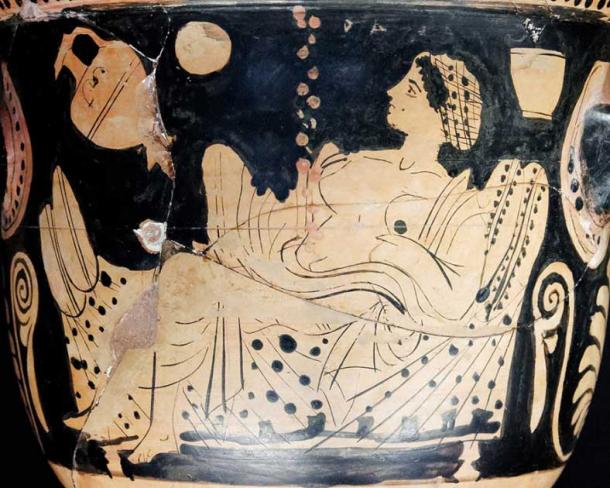
Danaë and the shower of gold, said to have caused the conception of Perseus. Side A from a Boeotian red-figure bell-shaped crater housed at the Louvre. ( Public domain )
The Birth of Perseus and the Deceit of Pollux
The fruit of the union between Zeus and Danae was a son named Perseus who Danae managed to hide from her father for some time. When Acrisius found out about the birth, he ordered the maid to be killed and then had Danae and Perseus enclosed in a chest and thrown into the sea. Waves, calmed by Poseidon, led the chest to the coast of Serifos, which is where Perseus grew up to become a strong man. The trunk was found by Dictys. It is worth noting the similarity to Moses who, according to the Bible, was left in the Nile inside a box of papyrus.
Dictys was a fisherman and the brother of the king of the island, Polydeuces, or Pollux. He probably lived in the famous Cave of the Cyclop, as the chest could have washed up on the beach at the front of the cave. Dictys hosted Danae and Perseus in his home, and they became members of his family; but his brother, King Pollux, wished Danae to be his wife and denied Dictys this union with her.
Another obstacle to the king was Danae’s son, Perseus, who was an extremely protective son. In an attempt to get his way, Pollux proclaimed his marriage with Hippodamia and asked that each inhabitant of the island provide the wedding gift of a horse. Perseus, being a fisherman, had no horses but pledged to bring the king the head of Medusa, the Gorgon, instead. Pollux readily accepted this commitment, as no man had ever returned alive from an encounter with a Gorgon. Pollux decided to keep Danae in the palace until Perseus returned with Medusa’s head.
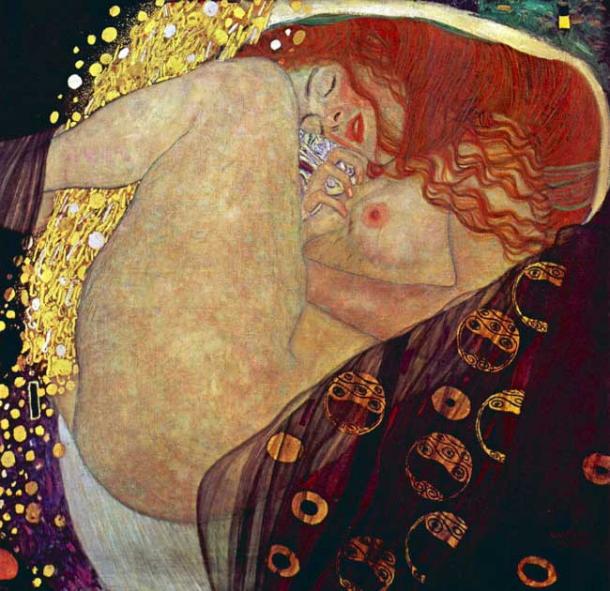
Danaë, the mother of Perseus, as depicted by Gustav Klimt. ( Public domain )
Perseus and the Hunt for Medusa
Medusa was one of the three mermaids which, according to Hesiod, lived across the ocean at the edge of the earth near the Night. Unlike her sisters who were immortal, Medusa was mortal. According to one version of the myth, she was thought to be beautiful and was raped by Poseidon . An angry Athena then cursed her and turned her into a terrible monster, though early versions of the myth claimed she was already a scaly monster with snakes entwined in her copper locks, pig tusks, large mouths, and large eyes that shot lightning. All who met her terrible gaze were said to be turned to stone.
Perseus left Serifos on a ship in order to search for Medusa. On the way he met Athena and Hermes, who told him how to kill the Medusa and, along with the nymphs, gave him the following weapons:
- The helmet of Hades to make him invisible as he approached his target.
- A magic bag in which to put the terrible head.
- Winged sandals to fly him to the rock in the middle of the sea where Medusa resided.
- The glittering shield to look upon Medusa.
- A sharp sword or scythe, which would cut through the hard neck of Medusa.
It was Athena who gave him the glittering shield and Hermes his winged sandals, though according to another source, the helmet, the winged sandals and the magic bag were given to him by the nymphs, and he received the sharp sword and the helmet when Athena led him to the land of the Hyperboreans (testimony derived from Pindar) where he offered a sacrifice.
Now Perseus needed to find where Medusa resided. Athena led him to the Graiae sisters, who were relatives of the Gorgons and the only ones who knew where they resided. The Graiae were three foul-faced crones, who in tragi-comic style shared just one eye and a tooth which they exchanged between themselves. Perseus approached them unseen and, taking advantage of the time of the exchange, grabbed the eye. Under the threat of losing it, the Graiae revealed the abode of Medusa to the hero.

The marriage of Perseus and Andromeda disturbed by Phineus by Hugues Taraval. ( Public domain )
Perseus and the Head of Medusa
When the hero approached Medusa he was invisible. Looking at her via the reflection on his shield, he cut off her head and put it in his bag. From her neck sprang the giant Chrysaor armed with a gold sword, and from the blood that fell in the ocean sprang Pegasus , the winged horse. These two creatures are said to have resulted from her mating with Poseidon. Why would Poseidon want to be united with such a monster, if not to create these two?
To escape the persecution of Medusa's sisters, Perseus flew away using the winged sandals, or according to other sources rode away on Pegasus. On the way back to Serifos, Perseus passed Ethiopia where he unexpectedly witnessed a strange spectacle. On a rock on the beach was chained a very beautiful woman, and around her stood a large, dumbfounded crowd, as well as a man and a woman dressed in mourning clothes.
Everyone was waiting for something. The chained woman seemed exhausted from crying and did not budge. Perseus, who flew into the air with his winged sandals, suddenly saw a big swirl of waves from which emerged a large sea monster. When the beast saw the young woman, it started to swim towards her.
Perseus took from his sack the head of Medusa and, like a predator bird, swooped down upon the monster. The beast stopped, slowly numbed, and turned into a rock that would not devour anyone else. The rescued woman was none other than Andromeda, daughter of Cepheus, king of the drone, and of Cassiopis, or Cassiopeia, granddaughter of Aeolus from Iopi. According to the myth, Andromeda had provoked the wrath of Poseidon because she boasted that she was more beautiful than the Nereids. The sea dragon had been sent by Poseidon as punishment. One would expect Poseidon to be angry with Perseus and want to avenge him. He did not, however, perhaps because Perseus brought to light his children, Chrysaor and Pegasus?
Perseus fell in love with Andromeda, although she was already engaged to her uncle Phineus, who had not raised any objections when his compatriots tied Andromeda to the rock as a sacrifice to the sea dragon. After her rescue, Andromeda agreed to marry Perseus. At the wedding Phineas and his supporters quarreled with and chased away Perseus and Andromeda. The hero escaped by pulling Medusa's head from his bag and pointing it toward his pursuers, turning Phineus to petrified stone.
The eldest son of Perseus and Andromeda, who was born in Ethiopia and was named Persian, stayed there and became the ancestor of the people who are known as Persians. Does this mean that the Persians came from the mixing of Ethiopians and Greeks?
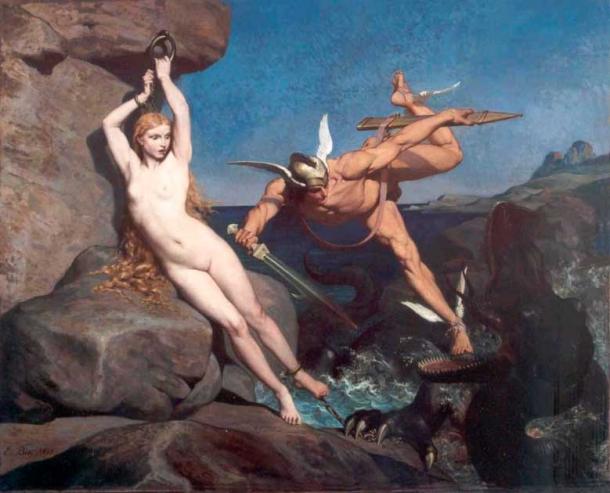
Perseus Freeing Andromeda, by Émile Bin. ( Public domain )
Perseus and the Fulfillment of the Prophecy
While Perseus was away, Pollux tried to take Danae—by force—to be his wife, but she resisted. As a result, when Perseus returned to Serifos he found his mother and Dictys bound by Pollux and prepared for sacrifice in the temple of Athena. Pollux refused to accept Perseus’ accomplishment, provoking the hero to show him Medusa’s head. The hero warned his own people not to look, and pulled the head of Medusa out of his bag. Those who looked at it, including Pollux, were petrified at once, and so Serifos came to be full of stones that looked like humans.
Perseus then devoted Medusa’s head to Athena, who picked it up and pinned it to the front of her shield, then handed it over to Hermes. Perseus also offered them the helmet of Hades, the kynin, the winged sandals, and the bag.
Meanwhile, Dictys assumed leadership of the island and Perseus prepared to return to Argos with his mother and wife. Perseus wanted to reconcile with his grandfather Acrisius, who although feeling proud of his grandson, wanted to avoid the meeting and therefore resorted to Larissa in Thessaly, which was built next to the River Peneus.
On the way to meet his grandfather in Argos, Perseus learned of the games held in Larissa. He sent his mother on to Argos, near his grandmother Eurydice, while he went to take part in the games. It was there, while taking part in the discus throw as part of the pentathlon, that Perseus threw the disk with great power and killed a spectator—who was none other than his grandfather, Acrisius. In the end, the prophecy of the Oracle at Delphi came true.
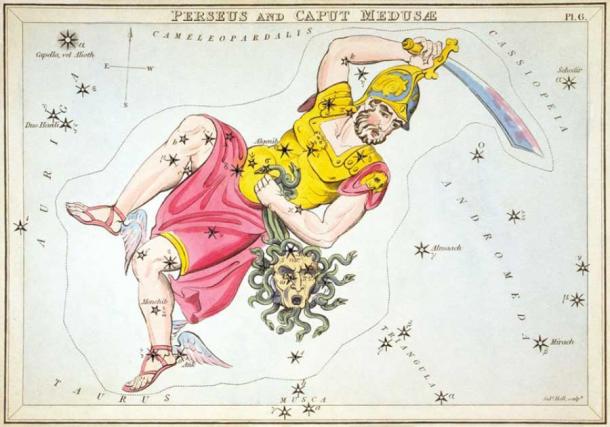
The constellation of Persus. ( Public domain )
The Legacy of Perseus
Perseus heartily felt sorry for the unintentional death of his grandfather and refused to take the throne, instead agreeing with his cousin, Megapenthes, to give him the throne of Argos in return for the throne of Tirynth and Mycenae. Perseus then became king of Tirynth and founded the city of Mycenae, naming it after the end of the sheath of his sword, myces . He turned to the Cyclops for help building the city, which became famous for its Cyclopean walls, that are visible even today.
Perseus and Andromeda had six children: Alcaeus, Heleus, Sthenelus, Elios, Gorgophonis and Electryon. Alcaeus was the father of Amfitryon, whose wife, Alcmene, would later bring Hercules into the world. Thus by Perseus, son of Zeus, starts the famous generation of Hercules , also a son of Zeus.
- Mycenae: The Ancient City Founded by Perseus
- The Golden Age of Heroes: The Glory of the Mycenaean Civilization
When Perseus died, the gods did not send him to Hades but, together with Andromeda and her parents Cepheus and Cassiopeia, sent him to the stars. Hence, the constellations of Perseus, Andromeda (consisting of 86 stars), and Cassiopeia and Cepheus were created in the northern hemisphere toward the polar star, capturing their stories on the celestial dome. Over the constellation of Andromeda is the Andromeda nebula, which looks like a bright cloud during the star-filled moonless nights.
Perseus and Dionysus
Another tradition relates Perseus and Dionysus to a relationship similar to the rivalry of Pentheus in Boeotia. Dionysus had gone to Argolis, defying the sovereignty of the local hero. The battle between them was fierce. On one side were Dionysus, his wife Ariadne and the Maenads, and on the other side was Perseus, who with the support of Hera killed a Maenad and petrified Ariadne by showing her the head of Medusa. The intervention of Hera inspired the two men to make peace, and a joint celebration with dances was setup in their honor. According to another tradition, Perseus killed Dionysus and dropped his dead body in the waters of Lerna.
The story of Perseus is one of the most incredible and detailed Greek myths , full of marvelous and powerful creatures, unimaginable weapons (that we couldn’t build even today), the interference of gods, and the accomplishment of magnificent deeds.
Top image: Perseus by Benvenuto Cellini. Source: Dimitris Kamaras / CC BY 2.0
By Natasa Tale
Apollodorus (Trans. Hard, R.) 2008. The Library of Greek Mythology . Oxford World’s Classics.
Atsma. A. J. No date. Perseus. Theoi Project. Available at: https://www.theoi.com/Heros/Perseus.html
GreekMythology.com. No date. “Perseus: The Slayer of Medusa” in Greek Mythology. Available at: https://www.greekmythology.com/Myths/Heroes/Perseus/perseus.html
No name. No date. “Perseus & Andromeda” in greeka . Available at: https://www.greeka.com/greece-myths/perseus-andromeda/
Ogden, D. 2008. Perseus (Gods and Heroes of the Ancient World) . Routledge.
Stefanidis, D. No date. “Perseus, son of Zeus and Danae” in Greek Mythology and Folktales from Greece . Available at: https://sigmapublications.com/txt_mth_en_en4.html
There's about 1-100 chances that there might be a similar story to the Greek one pertaining to Perseus. I Came across those 100 Odds.
The somehow the Germanic & Celtic stories has a princess locked in a tower by an angry grandfather fearing a prophecy that his grandson would kill him. There was a Golden Shower involved in the story that impregnated unfortunate imprisoned Princess.
Like Perseus grandfather the baby boy and his mother was tossed into a Chest floated out into the ocean in hopes of the King they'd die.
Didn't happen fishing village became their home. When Hero in the story grew older the monster he destroyed had only one Eye that shot fire frim it when it was opened unto it's enemies.
This demi-human power was such he could clear knock the Eye out of this monstrous Giant ancient god socket and kill him.
The giant monster had brother's and were constant rival's with another pantheon, they were often at War with each other hence why the Germanic Perseus was born to begin with.
That was exciting too find out about. Perhaps in addition too the Sea Monster Perseus killed a One Eyed monster capable of shooting Fire from its Eye which gave me pause and made me think if that's where the 3rd Eye concept originated.
Other than that it's funny Andromeda is Ethiopian Princess yet I don't see Ethiopia in the Painting probably why Joppa is preferred in other versions to Perseus story granted Bulfinch's mythical story of Perseus has Andromeda from Ethiopia as well.
In previous article right here at Ancient Origins, I do recall reading about Joppas name Jaffa. The origins of the name Joppa/Jaffa is associated with Noah's 3rd Son Japheth Father of All Clans, All Nation's, All tribe's, all language's and all Dynasties, & Kingdom's of Europe.
With Ethiopia coming up in Ancient Conversations possibly Japheth must have been married too an Ethiopian Woman of course they survived The Great Flood.
This tells me maybe Joppa aka Jaffa was named after Him before becoming known as Europe. I mean Gog, Magog, Gomer were said to be the name's of those who lived before The Flood.
Are so it was said. Since aspect's from The Bible; was brought up in this here article Genesis chapter 10 to 11, mentions Javan Japheth's great grandson exploring a place that had a Hot Spring's based on The Genesis Timeline it would have been after Great Flood & Tower of Babel.
Japheth would have settled in Jaffa I'm thinking via Italy once receiving from Noah The Land that would go too his Ancestors forever Aryans & Indo-Aryans in Europe. Although Indo-Aryans would travel too Bangladesh, India, Myanmar, other places these territories would be shared by Their Cousin's The Semites through Shem, Jaffa's brother.
Perhaps Javan who discovered the Hot Springs that will go to all of his Ancestors Jaffas great-grandson is Perseus.
Race of Giant's were still being seen by some populations of the Earth. Javan settled in Tarshish, Tarshish doesn't get mentioned again throughout The Bible till The Old Testament Prophet's such as Isaiah, Jeremiah, & Jonah.
Tarshish is Spain. Jaffa and his bloodline settled in Present Day Europe.
Two Actresses participated in Dr. Henry Louis Gates. Jr Finding your Root's the 1st Julianne Moore her ancestry is in Scotland.
The 2nd Actress Marissa Tomei her ancestry lies in Italy. Yet they are Blood cousins and Dr. Gates and his research team were left scratching their heads because they don't know how? They're related yet the science still proves that they are Blood Cousins to each other.
For me it's proof about Jaffa's bloodline in Europe. So hey Perseus might have walked the Earth but, his Bloodline might be extinct Now. Wild guess on my part but, Osthrogoths & The Heruli could be Great Candidates.
This is all I have to discuss about the Strange origins of Perseus. Until next Discussion everyone, Goodbye!

_deeds of the forefathers civilizations .. interesting story with a plenty of cues, thx .
Got a question to Our community. In the ancient pharmacopeias and in other medical records you are struck by the number of allusions to mixtures for bringing the organism into a transcendental state. Do we have info about it and this mixtures. If you have, give some clues, please.
Intricate legends are probably later devious additions.
Nobody gets paid to tell the truth.
I remember the writer John day finding a connection between the Perseus myth and the biblical book of Jonah. I always wondered where he found such a connection

Natasa Tale
Natasha is an alternative therapist and reflexologist with an interest in human psychology and human potential of the mind and body. She has had an interest in mythology and ancient history for many years and believes that many... Read More
Related Articles on Ancient-Origins
World History Edu
- Heroes in Greek Mythology
Perseus in Greek Mythology: Origin Story, Family, & Adventures
by World History Edu · April 27, 2023
Perseus is a figure from Greek mythology who is known for his heroic deeds and adventures. He was the son of Zeus and Danaë, and was famous for slaying the Gorgon Medusa and rescuing Andromeda from a sea monster. How did Perseus and Medusa’s paths get intertwined? And why did the Greek hero slay Medusa?
In the article below, World History Edu explores the life and adventures of this Greek hero, as well as other major things that he is best known for.
Perseus: Quick Facts
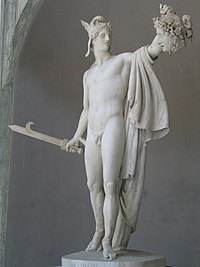
Perseo trionfante by Antonio Canova (1801) Vatican Museums, Rome
Father : Zeus
Mother : Danaë
Siblings : Apollo , Ares , Angelos, Athena , Dionysus , Helen of Troy , Hephaestus , Heracles , Hermes , Minos, the Horae, the Moirai, Persephone, Eris, Eileithyia, Aeacus
Consort : Andromeda
Sons : Perses, Alcaeus, Electryon, Cynurus, Mestor, Heleus, Sthenelus,
Daughters : Gorgophone, Autochthe
Best known for : slaying Medusa ; founder of Mycenae; great-grandfather of Heracles
Meaning of Perseus
According to some scholars and mythologists, this Greek hero’s name has its roots in the Greek word pértheinm, which means “to waste” or “to destroy”. In some cases, Perseus’ name has been interpreted as “destroyer of cities”.
The birth of Perseus
According to the myth, Perseus was born when Zeus visited the mortal woman Danaë in the form of golden rain. The myth goes on to say that Danaë gave birth to him while imprisoned by her father, King Acrisius.
Perseus’ Father
Zeus is the king of the gods in Greek mythology. He was the son of Cronus and Rhea and was born on the island of Crete. Zeus was known for his power and his thunderbolt, which he used to control the weather and strike down his enemies.
Zeus was also associated with hospitality, oaths, and justice, and he was often depicted as a protector of guests and strangers. He was known for his numerous love affairs and marriages, and he fathered many children, including Athena, Apollo , and Artemis .
Read More: 9 Most Famous Sons of Zeus
Perseus’ Mother and the prophecy from the Oracle at Delphi
Danaë is a figure from Greek mythology who was the daughter of King Acrisius of Argos. According to legend, an oracle predicted that Acrisius would be killed by his grandson, so he locked Danaë in a tower to prevent her from having any children. However, Zeus, who had taken a fancy to Danaë, visited her in the form of a shower of gold and impregnated her.
To protect Danaë and her child, Acrisius had them cast out to sea in a chest, but they eventually landed on the island of Seriphos, where Perseus was raised by the fisherman Dictys, the brother of King Polydectes.
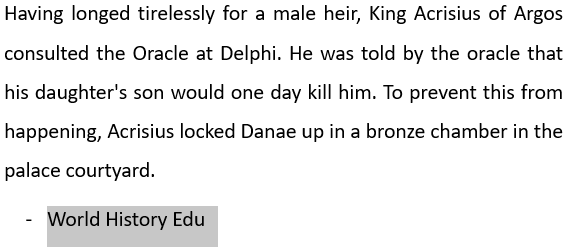
Perseus and King Polydectes
Having fallen deeply in love with Danaë, King Polydectes became envious of Perseus as the Greek demigod would not allow Polydectes anywhere near Danaë. Perseus saw Polydectes as a dishonorable man. As a result, an enmity developed between the two men. Therefore, the king came up with a plan to get rid of Perseus.
Polydectes demanded that Perseus bring him the head of Medusa as a gift. Medusa was terrifying gorgon whose gaze turned people to stone. The King assumed that Perseus would fail, and he would be free to pursue Danaë.

Perseus and Medusa
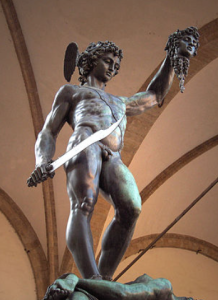
Perseus with the Head of Medusa by Italian sculptor Benvenuto Cellini (1554)
Perseus, however, was aided in his quest by the gods Hermes and Athena, who gave him a sword and a shield and helped him find the lair of the Gorgons. He was able to slay Medusa by using his shield to look at her reflection instead of directly at her, which turned her to stone.
Read More: The Three Gorgons in Greek Mythology
Perseus kills Polydectes
Upon his return to Seriphos with the head of Medusa, Perseus discovered that Polydectes had been abusive towards his mother, and he used the head of Medusa to turn him and his courtiers to stone. He then gave the kingdom to Dictys, the fisherman who had helped him and his mother during their exile on the island.
According to an alternate version of the story as told by Latin author Gaius Julius Hyginus, Polydectes married Danaë after Dictys brought her to him, and he raised Perseus in a temple of Athena. In this version, Polydectes did not mistreat Danaë and Perseus but instead protected them from Acrisius, who had discovered that they had survived and had come to Seriphos to kill them. Perseus made a pledge not to kill his grandfather, but at Polydectes’ funeral games, Perseus accidentally struck Acrisius with a discus, causing his death.
Perseus and the Graeae
In his quest to secure the weapons to defeat Medusa, the gorgon, Perseus was asked to find the Hesperides, the Nymphs of the West. But first, he had to seek the Graeae, sisters of the Gorgons who knew the whereabouts of the Hesperides.
The Graeae were three sisters who shared one eye and one tooth between them. Reluctant to give Perseus the information that he wanted, the Greek demigod had to find a way to get the information from them.
Perseus managed to steal the Graeae’s eye while they were passing it between them and refused to give it back until they revealed the location of the Nymphs. The Graeae eventually agreed, and Perseus set off to find the Nymphs and eventually slay the Gorgon.
In some versions of the myth, Perseus also tricked the Graeae into revealing how to defeat Medusa by threatening to keep their eye forever. In others, he used the eye to navigate his way through the realm of the Gorgons.
Items that aided Perseus in his fight against Medusa
Perseus was equipped with a range of powerful items to aid him on his quest to slay the Gorgon Medusa. The Hesperides provided him with a knapsack, known as a kibisis, to safely contain Medusa’s head.
Zeus gave him an adamantine sword, also known as a Harpe, and Hades’s helm of darkness to conceal his presence. Additionally, Hermes lent Perseus a pair of winged sandals to allow him to fly, while Athena presented him with a polished shield. With his arsenal at the ready, Perseus set off towards the Gorgons’ cave.
Exactly how did Perseus slay Medusa?
As Perseus entered the Gorgons’ cave, he found Medusa sleeping. Using his polished shield as a reflection, he was able to approach her safely and swiftly decapitate her. In a moment of wonder, Pegasus, the legendary winged horse, and Chrysaor, the golden-sworded giant, sprang forth from her severed neck. The two remaining Gorgons gave chase, but Perseus, protected by his helm of darkness, was able to escape.
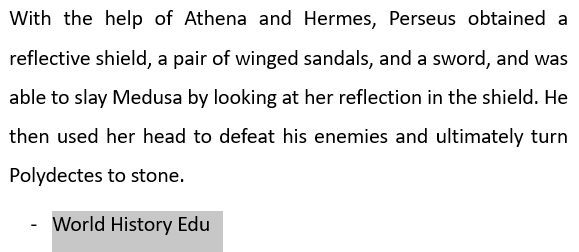
Perseus and the Greek Titan Atlas
After this feat, Perseus continued on to King Atlas, seeking his hospitality, but was met with rejection. In response, Perseus revealed the head of Medusa, turning the king to stone as a punishment.
- The Twelve Titans in Greek Mythology
- Everything you need to know about Atlas, the Greek Titan that carried the heavens on his shoulders
Perseus and Andromeda

Perseus also rescued Andromeda, a princess who had been chained to a rock as a sacrifice to a sea monster. He used the head of Medusa to turn the monster to stone and marry Andromeda.
During his journey back to Seriphos, i.e. from slaying Medusa, Perseus made a stop in the kingdom of Aethiopia (Ethiopia), a mythical land ruled by King Cepheus and Queen Cassiopeia. However, the queen’s pride led to disaster when she boasted that her daughter Andromeda was as beautiful as the Nereids. As punishment, Poseidon sent a sea serpent called Cetus to wreak havoc on the land, destroying both people and animals.
The oracle of Ammon revealed to the terrified people of Ethiopia that the only way to stop the devastation was to sacrifice Andromeda to the monster, and so the princess was bound and left naked on the shore. But Perseus arrived just in time, slaying the beast and freeing Andromeda. As a result, he won her hand in marriage.

Perseus Freeing Andromeda by Italian painter Piero di Cosimo (c. 1515) – the Uffizi Gallery in Florence, Italy.
During the marriage ceremony, a brawl broke out between Perseus and Phineus, son of Belus. Andromeda had earlier been promised to Phineus before the arrival of Perseus. Enraged by the actions of Perseus, Phineus plotted against the savior of Ethiopia. According to Ovid’s Metamorphoses , when Perseus found out about the plot, he used the head of Medusa to turn Phineus to stone.
After getting married, Perseus and Andromeda left for the Kingdom of Tiryns in Argos, where they established the city of Mycenae.
Perseus’ votive gift to the goddess Athena
After completing his quest, Perseus returned the magical items he had borrowed to their respective owners. As a gesture of gratitude, he gave Medusa’s head to Athena as a votive gift. Athena then placed the Gorgoneion, the head of Medusa with its power to turn people to stone, onto her own shield which was carried by Zeus.
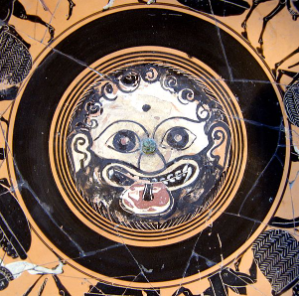
The Gorgoneion in ancient Greece was believed to have the power in deflecting misfortune or averting the evil eye. Image: Gorgoneion on the Tondo of an Ancient Greek Attic black-figure cup – Cabinet des médailles de la Bibliothèque nationale de France, Paris, France.
The Children of Perseus
By Andromeda, Perseus fathered a number of children, including seven sons and two daughters. The sons of Perseus are:
- Perses: He was a legendary hero who founded the city of Persia. Perses was left in Aethiopia by his parents.
- Alcaeus: He was a warrior who participated in the expedition of the Argonauts. He was also the grandfather of Heracles through his stepson Amphitryon.
- Electryon: He was a king of Mycenae and the father of Alcmene, the mother of Hercules.
- Cynurus: He was the eponymous founder of the city Cynura, an ancient district on the eastern coast of the Peloponnese.
- Mestor: He was a king of Taphos and the father of Hippothoe.
- Heleus: was a king of Mycenae and the father of Iphicles, the half-brother of Hercules.
- Sthenelus: He was a king of Mycenae and the father of Eurystheus, who was responsible for assigning the Twelve Labors to Hercules.
The daughters of Perseus are:
- Gorgophone: She was married to Perieres, the king of Messenia, and was the mother of Aphareus and Leucippus.
- Autochthe: She married Aegeus, a mythical figure who played a role in the founding of Athens. By Aegeus, she gave birth to many daughters.
The relationship between Perseus and Heracles
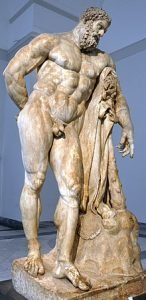
The Farnese Hercules (216 CE), Roman marble statue on the basis of an original by 4th century BC Greek sculptor Lysippos.
Alcaeus, a prince of Mycenae, was born to Perseus and Andromeda, and was the sibling of Perses, Heleus, Mestor, Sthenelus, Electryon, Cynurus, Gorgophone, and Autochthe. Alcaeus had multiple wives, including Astydameia, daughter of Pelops and Hippodamia, Laonome, daughter of Guneus, or Hipponome, daughter of Menoeceus. He was the father of Amphitryon, Anaxo, and Perimede.
Amphitryon was the husband of Alcmene, Electryon’s daughter. This made him the stepfather of the Greek hero Heracles.
According to the myth, Zeus, the king of the gods, fell in love with Alcmene and disguised himself as Amphitryon to sleep with her. As a result, Alcmene became pregnant with twins, one fathered by Zeus (Heracles) and the other by Amphitryon (Iphicles).
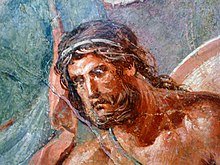
Amphitryon was a famous figure in Greek mythology and the son of Alcaeus and Astydameia (or possibly Laonome or Hipponome). He is best known for his marriage to Alcmene, who was the mother of the legendary hero Heracles.
Perseus – the legendary founder of Mycenae
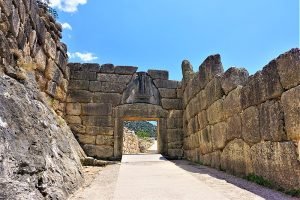
The Lion Gate: the main entrance of the Mycenae citadel
Mycenae (located in present day Argolis, Greece) was an ancient city in the northeastern part of the Peloponnese peninsula in Greece. It was a significant center of Mycenaean civilization, which flourished in Greece during the Late Bronze Age, from around 1600 BCE to 1100 BC.
Mycenae is best known for its impressive archaeological site, which includes the ruins of the city’s fortified walls (i.e. the walls of Tiryns), palaces, and tombs. The most famous of these tombs is the Treasury of Atreus, also known as the Tomb of Agamemnon, a massive beehive-shaped tomb built in the 13th century BC.
Other famous ruins of Mycenae is the Lion Gate, the main entrance to the citadel of Mycenae. Located in the northeastern side of the acropolis, the gate was built somewhere 1252 BC. The name comes from the relief sculpture of two lionesses above the entrance.
According to Greek mythology, Mycenae was founded by Perseus, but its golden age is associated with the legendary king Agamemnon, who led the Greeks in the Trojan War . In Homer’s epic poem the Iliad, Mycenae is described as a powerful city-state, rich in gold and ruled by Agamemnon. Also according to Homer, the name of the city was derived from the nymph Mycene, the daughter of the river god Inachos of Argos.
Excavations at Mycenae have revealed evidence of a sophisticated civilization with a strong military and a complex social and political hierarchy. The city was well-connected to other centers of Mycenaean culture, such as Tiryns, Pylos, and Thebes, and traded with other civilizations in the eastern Mediterranean.
The archaeological site of Mycenae is a UNESCO World Heritage Site. It received the honor in 1999. Today, the site is a popular destination for tourists interested in ancient Greek history and culture.
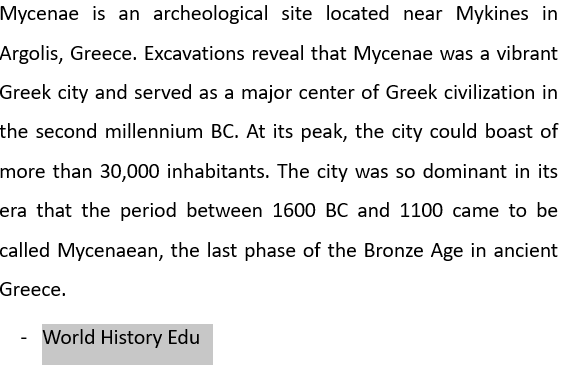
How Perseus accidentally killed his grandfather King Acrisius
After completing his various quests, Perseus returned to his hometown of Argos. When news of Perseus’ return reached his grandfather Acrisius, the was consumed by the the prophecy that his own grandson would cause his death. As a result, Acrisius went into voluntary exile in Pelasgiotis (Thessaly). Meanwhile, Perseus competed in the funeral games held by Teutamides, king of Larissa, in honor of his father. During the discus throw event, Perseus’s discus went off course and accidentally struck Acrisius, killing him on the spot.
In a different account, it was said that Acrisius had been driven into exile by his brother Proetus. Perseus turned Proetus into stone using the Gorgon’s head and restored Acrisius to the throne. However, Acrisius accused Perseus of lying about slaying Medusa. To prove his innocence, Perseus showed Acrisius the Gorgon’s head, thereby fulfilling the prophecy.
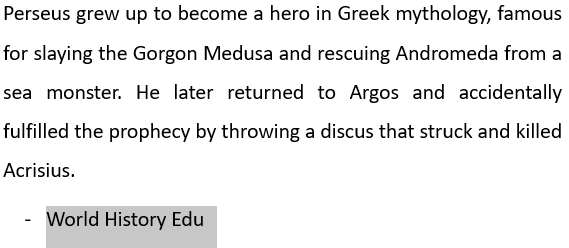
Perseus and King Acrisius of Argos
How Perseus founded the ancient Greek city of Mycenae and established the Perseid dynasty
According to the myths, Perseus accidentally killed his maternal grandfather, King Acrisius of Argos. This action of the demi-god meant that he could not inherit the kingdom of Argos. Perseus then proceeded to trade his realm with the realm of his cousin, Megapenthes.
Known as the son of Proetus, Megapenthes was the ruler of Tiryns. Perseus then became the king of Tiryns. It was during his reign that he founded the city Mycenae. Perseus also established the Perseid dynasty, with his son Electryon (by his wife Andromeda) becoming the second ruler to hail from the dynasty.
Upon the death of Electryon, the throne passed on to Sthenelus, a son of Perseus. Sthenelus married Nicippe, a daughter of King Pelops of Elis. The pair had a son called Eurystheus, who tried to avenge the death of his father by imposing a set of 12 arduous labors (i.e., the Twelve Labors) on the Greek demigod Heracles.
Aside from the generally accepted myth that Heracles received those labors as penance for murdering his family, it is also stated that Heracles was punished because his son, Hyllus, killed Sthenelus. As a result of the enmity between Heracles and Eurystheus, the latter swore to wage war against the Heracleidae (Heraclids), the descendants of Heracles.
Ultimately, the Heraclids killed Eurystheus and all his sons, bringing an end to Perseid dynasty, which was succeeded by the Atreid dynasty, with its first ruler being Atreus. The myth goes on to say that Atreus gave birth to two sons – Agamemnon and Menelaus, who inherited the kingdoms of Mycenae and Sparta, respectively.
Read More: Greatest Heroes in Greek Mythology
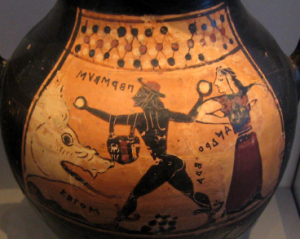
Greek demigod Perseus saving Andromeda from Cetus, depicted on an amphora in the Altes Museum, Berlin
The generally accepted account in Greek mythology is that Perseus is one of the most famous heroes in Greek mythology, known for his strength, bravery, and cunning in overcoming seemingly insurmountable challenges.

Bibliography
Apollonius Rhodius, Argonautica . George W. Mooney. London. Longmans, Green.
Beekes, Robert Stephen Paul. Etymological Dictionary of Greek. Leiden and Boston: Brill, 2009.
Blakolmer, Fritz (2010). “Images and Perceptions of the Lion Gate Relief at Mycenae during the 19th Century”. In F. Buscemi (ed.). The Representation of Ancient Architecture in the XIXth Century. Cogitata. pp. 49–66.
Bury, J. B.; Meiggs, Russell. A History of Greece (4th ed.). London: MacMillan Press, 1975.
Castleden, Rodney. The Mycenaeans. London and New York: Routledge, 2005.
French, Elizabeth Bayard. Mycenae: Agamemnon’s Capital. Stroud: Tempus, 2002.
Herodotus, The Histories with an English translation by A.D. Godley. Cambridge. Harvard University Press.
Mylonas, George Emmanuel. Mycenae and the Mycenaean Age. Princeton, NJ: Princeton University Press, 1966
Ogden, Daniel. “Perseus.” Routledge & CRC Press, 2008
Tags: Aethiopia Andromeda Athena Danaë Eurystheus Greek demigods Heracles King Acrisius of Argos Medusa Perseus Perseus and Medusa Polydectes The Gorgoneion The Gorgons The Perseid dynasty Zeus
You may also like...
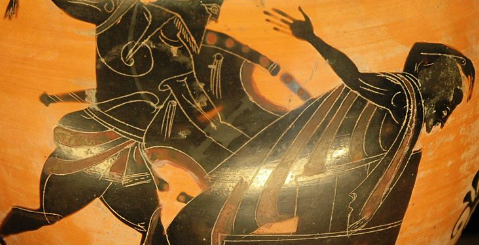
Neoptolemus in Greek mythology: The Greek warrior who played a significant role in the fall of Troy
April 7, 2023
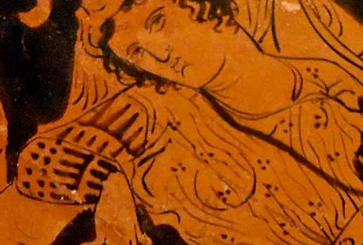
The myth of Sarpedon, the son of Zeus who died fighting in the Trojan War
February 6, 2022
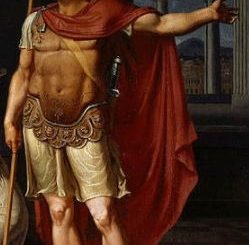
12 Major Myths about Hector, the Great Trojan Warrior in Greek Mythology
April 26, 2021
Leave a Reply Cancel reply
Your email address will not be published. Required fields are marked *
Save my name, email, and website in this browser for the next time I comment.
- Next story Dahomey Amazons: Just how fierce were the all-female West African warriors?
- Previous story The Bay of Pigs Invasion and 9 other US Military Interventions of the 20th Century
- Popular Posts
- Recent Posts

What was the perception of miasma from around the world?

History of the Last Supper Painting and the technique used by da Vinci

History & Major Facts about the Miasma Theory

Life and Political Career of Charles James Fox

Who were the closest friends and allies of Julius Caesar?

Greatest African Leaders of all Time

Queen Elizabeth II: 10 Major Achievements

Donald Trump’s Educational Background

Donald Trump: 10 Most Significant Achievements

8 Most Important Achievements of John F. Kennedy

Odin in Norse Mythology: Origin Story, Meaning and Symbols

Ragnar Lothbrok – History, Facts & Legendary Achievements

9 Great Achievements of Queen Victoria

12 Most Influential Presidents of the United States

Most Ruthless African Dictators of All Time

Kwame Nkrumah: History, Major Facts & 10 Memorable Achievements

Greek God Hermes: Myths, Powers and Early Portrayals

8 Major Achievements of Rosa Parks

10 Most Famous Pharaohs of Egypt

How did Captain James Cook die?

Kamala Harris: 10 Major Achievements

Poseidon: Myths and Facts about the Greek God of the Sea

How and when was Morse Code Invented?

Nile River: Location, Importance & Major Facts

The Exact Relationship between Elizabeth II and Elizabeth I
- Adolf Hitler Alexander the Great American Civil War Ancient Egyptian gods Ancient Egyptian religion Aphrodite Apollo Athena Athens Black history Carthage China Civil Rights Movement Constantine the Great Constantinople Egypt England France Germany Ghana Hera Horus India Isis John Adams Julius Caesar Loki Military Generals Military History Nobel Peace Prize Odin Osiris Pan-Africanism Queen Elizabeth I Ra Ragnarök Religion Set (Seth) Soviet Union Thor Timeline Women’s History World War I World War II Zeus
Fascinating Facts About Perseus, The Greek Mythological Hero
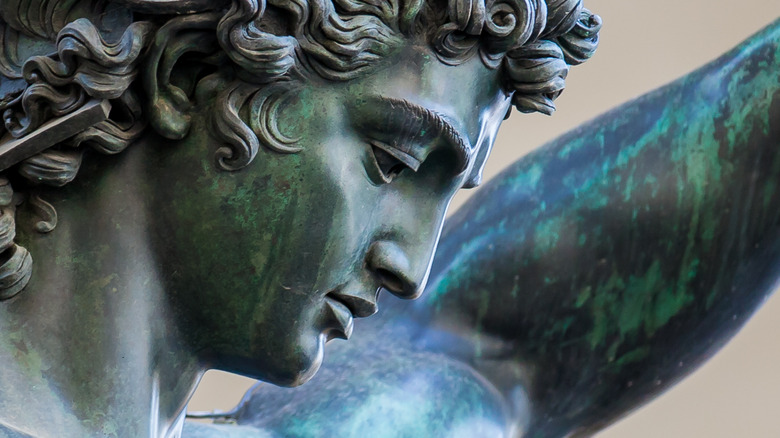
There are many ancient Greek gods, heroes, and monsters that have become household names. There probably isn't a soul out there who at least doesn't recognize the name Zeus or Heracles (though the latter is likely better known by his Roman name, Hercules). Perseus can count himself among the lot of ancient Greek personalities whose name will at least ring a few bells.
As with many other heroes, he is most known for one big thing. Like Theseus, who is known for slaying the minotaur, and Bellerophon, who is known for riding Pegasus, Perseus is primarily known for slaying Medusa , the mortal Gorgon sister who could turn anyone to stone by simply looking at them. Which is terrifying, and had done away with many a good — and bad — ancient Greek denizen. But not Perseus: Immortalized in countless statues and paintings, Perseus is the one who holds aloft the head of the snake-haired woman in triumphant silhouette.
Nevertheless, Perseus did much more than that. And unlike heroes like Theseus , who have dubious reputations that involve some shady business, Perseus was almost entirely a positive presence in the ancient Greek landscape. So much so that he is something of an oddity. In a world of bitter and jealous gods where even the good mortals oftentimes got screwed over, Perseus managed to not only do good wherever he went, but kept on sound footing with the gods — which is a miracle in and of itself. Here's a look at some fascinating facts about Perseus.
His dad was a golden shower
Lineage is huge in Greek mythology. If you're descended of mere mortals, your lot in life is always a bit stunted. But thanks to some remarkably sex-craved gods, there were plenty of such people who boasted at least one immortal parent. For Perseus, his father — like so many others — was Zeus. Only not Zeus as you might know him. No, Zeus did not impregnate Perseus' mother by coming down to earth in his toga and flinging lightning bolts. Instead, he disguised himself as a golden shower. Which, to be clear, is exactly as it seems — a bunch of golden water drops. That was it. That's Perseus' father.
The story goes that Danae, Perseus' mother, had been locked up by her own father, Acrisius, according to the Theoi Project . He was the king of Argos, but a prophecy foretold that Danae's son would kill Acrisius. In order to prevent such a deadly grandson, Acrisius did what he thought to be the logical thing and kept her away from all men — only he greatly underestimated Zeus' sex drive.
Zeus has a long, long track record of disguising himself as things in order to impregnate mortal women. Some of his highlights include a swan, a satyr, and a bull — many of which he took the form of more than once, according to " Zeus Who? " But as gross and awful as Zeus is, maybe he deserves the smallest bit of credit for his creativity in becoming a literal stream of golden liquid.
He spent his infancy locked in a chest
Seeing as how Perseus' grandpa Acrisius locked up his own daughter (per the Theoi Project ) in an attempt to keep her from getting pregnant, you can bet that he wasn't just going to let her give birth to the son that was prophesied to be his killer. If there is one thing everyone in ancient Greece should know — other than to avoid the gods whenever possible — it's never to take what the Oracle predicts for granted. The Oracle is always right.
Danae gave birth to a strong baby boy who looked perfectly capable of one day slaying his grandfather, and she managed to keep him secret for a few years. Still, being impossible to keep the child hidden forever, eventually Acrisius enacts Plan B, since his Plan A of keeping her in a cage failed so spectacularly. This time, rather than a cage, he locks both Danae and infant Perseus in a wooden chest, drills a few holes in the top, and casts them into the sea, according to "Danae and Perseus on Seriphos" (via the American Journal of Archeology ).
The chest floated along the sea for quite some time before it was plucked out of the waters by a fisherman, who also just so happened to be the brother of King Polydectes. The king brought Danae and Perseus into his city and married Danae, who, at this point, probably just wanted to be left alone.
He is Heracles' great-grandfather
Perseus did some remarkable things. He slayed the mortal Gorgon sister Medusa, which no one else had been able to do (per the Theoi Project ). He slayed a sea monster that Poseidon had sent himself and avoided any repercussions from the bitter, spiteful god of the sea (per the Theoi Project ). He fell in love — actual love, not the Zeus kind of love that was so common in ancient Greek heroes — and even got on well with his wife's Ethiopian family.
But another pretty incredible thing Perseus did was to have a family that was remarkably successful — that didn't happen in ancient Greek mythology. After all, according to Mythology Source , the hero Jason had his children slain by Medea, and Theseus ditched Ariadne after she saved his life, just to name two.
But counted amongst the mass of descendants from Perseus that made an actual difference in legendary Greece, is one name that would surpass even Perseus in terms of heroics, and that name, of course, is Heracles, Perseus' great-grandson. Heracles is considered by many to be the greatest hero of ancient Greece, but his children went on to found over fifty Greek cities — and that all traces back to Perseus.
He killed an entire sea monster in the name of love
While every Greek hero has their crowning achievement, and Perseus' is undoubtedly Medusa, it's not his only one. Much like how Theseus also defeated the Marathon Bull (per the Theoi Project ), Perseus also defeated an entire sea monster. And his motivation? True love. The short version of this story is that the mortal Ethiopian queen Cassiopeia claimed that her daughter Andromeda was more beautiful than the Nereids, who also happened to be Poseidon's daughters, according to the Theoi Project . Well, being a typically bitter and jealous Greek god, Poseidon didn't like this, and required Cassiopeia to offer her beautiful daughter as food to a sea monster — which Poseidon would send along presently.
Conveniently for Andromeda, at the same time the sea monster arrived, so too did her future husband, the mighty and strangely morally upright Perseus, fresh off of slaying Medusa. Seeing Andromeda, he immediately fell in love, pulled his ship over, and slayed the sea monster. How he did this is up for interpretation, according to " Perseus and Andromeda ," by Kyle M. Phillips Jr., but he may have slayed it with a sword, or he may have just thrown rocks at it. Whatever the case, he did, in fact, slay the monster, and what better way to win over a soul mate?
Perseus and Andromeda sailed home together, they were married, and somehow Poseidon either never got wind of it — or something else upset him, and he forgot all about it.
He's the forefather of practically all of ancient Greece
Plenty of ancient Greek heroes did some cool things during their lifetime, had a few kids, and then faded away, leaving very little to longevity. But yet again, Perseus is an exception to this trend of one-and-done heroism. Not only did Perseus showcase pretty gnarly individual feats of dominance and found the city of Mycenae, but he is also the father of some pretty incredible children and grandchildren, all of whom went on to do their own great things and found their own great cities: All of it traces back to one man — Perseus.
One look at his family tree on Mythology Source will ring some bells for many people. There are names directly descended from Perseus that continued on that legacy of founding entire cities. Heracles, for example, is a great-grandson of Perseus (also a half-brother, because, you know ... Zeus), as is Perses, who is the founding leader of the entire Persian empire. Perseus' daughter, Autochthe, married Aegeus, the King of Athens and father of Theseus of minotaur fame. Perseus' other daughter, Gorgophone, gave birth to the King of Sparta, who would go on to marry Helen of Troy. Gorgophone was also the grandmother of Penelope, who married Odysseus.
The list goes on, but for those keeping track at home, that means that Heracles, Theseus, the Persian Empire, Sparta, Troy, and Odysseus (among others) all have Perseus to thank one way or another.
He accidentally killed his grandpa with a discus
Perseus' grandfather Acrisius went to great lengths to prevent Perseus from ever being born, per the Theoi Project . After the Oracle predicted that Acrisius would be killed by his grandson, he locked his daughter in a cage, only to be foiled by horny Zeus. He then locked his daughter and grandson in a wooden chest and set them adrift at sea, hoping that this would take care of things once and for all.
Acrisius knew the deal — don't underestimate the Oracles. They are never wrong. Though Acrisius clearly missed the plot because, let's say it again: they are never wrong. Meaning that no matter his efforts, it was inevitable that Acrisius was going to be killed by his grandson.
To be fair to Perseus, he and his mother Danae had gone on their way to live a new life. Perseus wasn't actively seeking his grandfather to slay him in accordance with the Oracle's prediction. In fact, it seemed like Perseus had moved on from that entirely. He had a beautiful wife, he was revered for his heroics, and he had a new city. But unfortunately for Acrisius, according to the Theoi Project , at the funeral of another king where both he and Perseus were in attendance, the mighty Perseus was tossing the discus with fellow funeral-goers: One throw got away from the mighty hero, mortally struck Acrisius in the head, and somewhere far away the Oracle probably cackled, because Acrisius was dead by his grandson's hand.
He had a working relationship with the gods
Among all the remarkable things Perseus managed to accomplish, from his individual heroics to his functioning family, he is also one of the few Greek heroes to not only see no deadly repercussions from the gods, but also somehow keep a really positive relationship with them. And perhaps the best example of this relationship, and how he maintained it, is seen in his quest to slay Medusa.
Naturally, this was never going to be an easy task, but Hermes and Athena came in to help. Hermes gave Perseus sandals with wings that allowed Perseus to fly, and Athena gave Perseus the cap of Hades, which made him invisible, according to Britannica . Naturally, both of these items were rather valuable to Perseus in his death-defying quest to slay a Gorgon, but once the quest was complete, he didn't abscond with the items and use them to other ends.
Once he had accomplished his task, he gave the items back to the gods and even went one step further, giving the head of Medusa to Athena, who put it on her shield. So not only did Perseus repay his loan, but he did so with interest. In doing so, Perseus demonstrated how not to anger the gods.
The battle with the Gorgons didn't end with the death of Medusa
You'd think that the hardest part of a quest to slay the mortal Gorgon sister Medusa would be actually slaying Medusa. But that, for Perseus, was arguably the easy part. He slipped in while she was asleep and cut her head off. Boom. Done.
You could say that the two valuable items he got from the gods — the Cap of Hades, which granted invisibility, and the winged sandals which allowed him to fly — were not even needed for the first part, according to "Perseus' Battle with the Gorgons" (via Transactions and Proceedings of the American Philological Association ). After all, being invisible wouldn't stop you from turning to stone if you caught Medusa's eye.
It was what came next that was the hard part — escaping from Stheno and Euryale, the Gorgon sisters that were immortal. Naturally, they didn't take kindly to their sister being slain, and they got after Perseus, intent on making him pay. For Perseus, though, their fiery vengeance may have been his saving grace. Rather than simply turn him to stone with a stare, the immortal sisters wanted to catch him and tear him apart. Sadly for them, Perseus utilized those handy items from the gods and managed to escape their wrath.
He actually had a conscience
Perseus was unique enough as is, but as it turns out, he was actually a rare Greek macho man who had a functioning conscience fully equipped with feelings of guilt. Sure he slayed Medusa, but his only reason for doing so was because he was ordered to by King Polydectes.
Then there's the unfortunate incident of accidentally killing his grandfather Acrisius, the king of Argos, with a stray discus. More than a few Greek heroes — or indeed anyone — would probably have been pretty pleased with finding themselves the King of Argos. But not our friendly hero Perseus, though he was technically next in line for the throne, being Acrisius' grandson. He didn't, however. He was so wracked with guilt that he simply could not rule where once his grandfather ruled. Never mind the fact that his grandfather had tried to kill him when he was a boy. Instead, according to ThoughtCo. , Perseus went to a neighboring city, Tiryns, which was far less developed than the flourishing kingdom of Argos, and traded kingdoms. Megapenthes, the ruler of Tiryns, was happy to downgrade Perseus in favor of stepping up himself.
Of course, Perseus would go on to move the capital to the brand new city of Mycenae, which would become one of the greatest cities in Greece, but it can never be said that Perseus got there by hook or by crook — he was one honest dude.
He used Medusa's decapitated head as a weapon
After Perseus decapitated Medusa, escaped the immortal sisters, and hopped his ship home, he had, in a bag, a very powerful object — the head of a Gorgon. While he did eventually give it to Athena once he got home, he first had some errands to accomplish with the head.
The first stop was Andromeda and the sea monster. Granted, this was an unplanned stop, but regardless, Perseus may well have used the Gorgon's head to turn the sea monster to stone. According to "Perseus and Andromeda" (via the American Journal of Archeology ), it's unclear how he did the deed, only that he did it — but a literal petrification ray would be very tempting to use in these circumstances.
Even if he didn't, he did use it as soon as he got home. King Polydectes, who had fished baby Perseus and mother Danae out of the sea, was not a great guy. He had forced Danae to marry him and ordered Perseus to slay Medusa. Those were two no-nos for Perseus, and he brought it full circle by using the head of Medusa to turn Polydectes into stone, according to the Theoi Project .
He actually had a happily ever after
It seems nobody ever lives happily ever after in ancient Greek mythology. Either you die miserable from an unfulfilling life, or your success irks one god or another into smiting you for the rest of eternity. It simply always happened. After all, it's hard to succeed without stepping on a few heads to rise up, and when those heads are capable of sending sea monsters after you, the probability of an actual happily ever after is remarkably thin.
But Perseus did it, as Mythology Source can attest to. Despite having war waged on him by the immortal Gorgons and slaying Poseidon's sea monster, he avoided any repercussions. He always gave the gods back what they gave him, and when it came to his marriage, Perseus truly loved Andromeda: They had tons of children together, and they legitimately lived happily ever after, to the end of their days.
Of course, some of Perseus' children were rambunctious, and not all of them lived up to the high standards of their parents, but as for Perseus himself, he had a model life. He was a hero, a leader, and a family man — and he always repaid his debts.

Perseus Saves Andromeda: The Story Behind the Greek Myth
By Andy Watkins
Updated on September 2, 2021

A common story of Greek mythology is that of a hero saving some beautiful women from a monstrous beast.
This type of story is told and retold in so many forms across the Greek myths. But to tell you the truth, one of my favourite of the lesser know stories is that of Perseus and his rescue of Andromeda. So, lets dive straight in, how did Perseus save Andromeda?
As a gift for the King Polydectes , the Greek hero Perseus had been tasked with the killing of Gorgon Medusa and bringing back her head. Upon killing Medusa, Perseus was flying back to Greece using his winged sandals and while passing over Palestine he spotted the beautiful Princess Andromeda chained to the rocks below. She was to be eaten by a great sea monster sent by Poseidon. Perseus fought the beast and using the head of Medusa turned the monster to stone.
- What Is the Story Behind Andromeda, Cepheus, Cassiopeia and Perseus?
In order to better understand the story behind Andromeda, Cepheus and Cassiopeia it is best to introduce the main characters in a bit more detail first.
- Perseus – the son of Zeus and all round talented warrior who is comes to wield the head of Medusa.
- Andromeda – the daughter of Cepheus and Cassiopeia, she is said to be very beautiful and is a hapless victim in this story.
- Cepheus – the king of Joppa and quite a weak willed individual.
- Cassiopeia – She was the wife of Cepheus. She is said to be very vain and described herself as more beautiful than the sea nymphs angering Poseidon. She later becomes one of the constellations in the sky.
- Polydectes – the king of Seriphos, he demanded the gift of the head of Medusa and wishes for the hand of Perseus’ mother in marriage.
- Medusa – one of the three Gorgon sisters, she was transformed into a hideous monster by Athena. She is feared by many across the land and many heroes attempt to fight and kill her.
So, lets begin. The King of Argos, Acrisius, caught wind of a prophecy, that he would one day be killed by his grandson. He only had one daughter, so he locked her away and stopped her from having any contact with anybody from the outside. The king of the Olympian gods Zeus had other plans, one day he made his way into the room of Danae and made love to her. Nine months later, Perseus was born. Not wanting to anger Zeus, Acrisius threw both Danae and Perseus into the sea figuring that if they were to die then Poseidon and not he would be blamed.
Zeus, conspiring with his brother Poseidon, ensured that the seas transported Danae and Perseus to the island of Seriphos, 100 miles south of Athens, where they met the friendly fisherman Dictys. Here, Perseus grew into a strong and handsome young man. The king of Seriphos, Polydectes, became interested in Danae and ruthlessly pursued her until Perseus had to intervene and defend her. Polydectes grew angry and vowed revenge. He chose another wife, but and as a wedding gift demanded the head of Medusa from Perseus, something her know to be an impossible feat.
To aid Perseus in his venture he was given some winged shoes and a sword by Hermes and a bronze shield by Athena. Anyone who looked into the eyes of Medusa was turned to stone. So, Perseus used the reflection in the bronze shield to search for Medusa and when he found her he was able to chop off her head. Having put the head in a bag he started his homeward journey. This is when we meet Andromeda.
On his way back he spotted Andromeda chained to some rocks next to the sea. Her mother had made the claim that she was more beautiful than the ocean nymphs called Nereids . This had greatly angered the Olympian god of the sea, Poseidon. He decided to unleash a terrible sea monster on the kingdom of Joppa. The king of Joppa, not knowing how to deal with the beast, sought the advice of the Oracle. This oracle told him that he should sacrifice his daughter Andromeda to the monster. This way, the monster would then leave. This is how Andromeda ended up chained to the rocks awaiting the sea monster.
Perseus, enraged by the story, decided to fight the sea monster. He used his winged shoes, and bronze shield and his sword to fight off the beast, but it wasn’t enough. As a last option he reached into his bag for the head of medusa . He pulled out the head and directed the eyes towards the sea monster. The sea monster was instantly turned to stone. This Andromeda was saved by Perseus. Cepheus was so happy at the killing of the great monster, that he allowed Perseus to marry Andromeda.
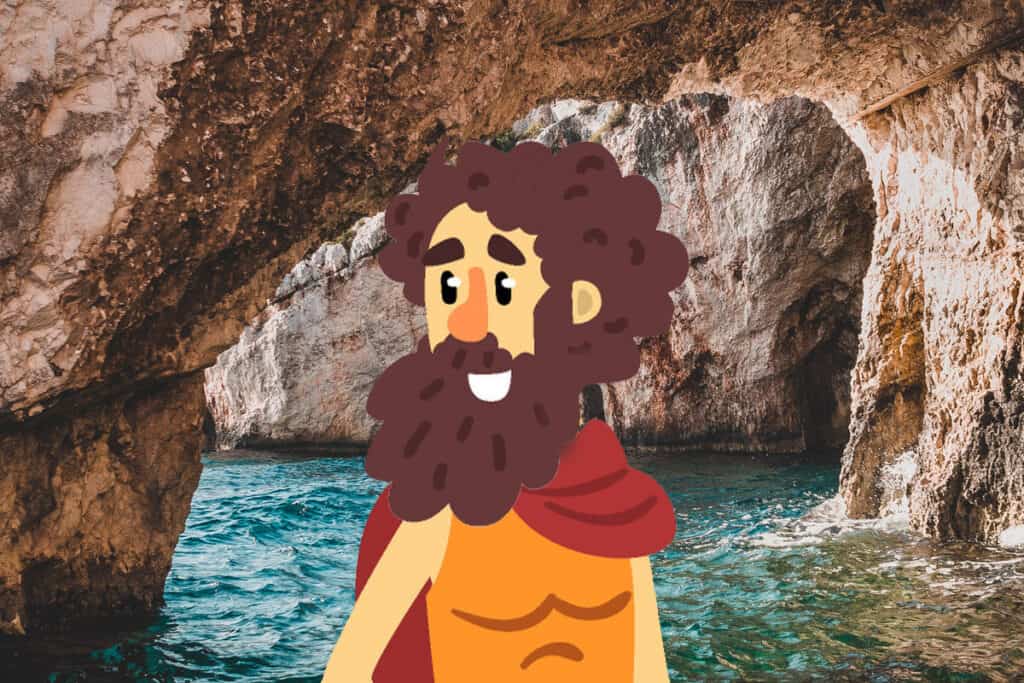
What Happens to Perseus and Andromeda?
Perseus and Andromeda are married in Joppa and they spend a year together there. But, eventually, Perseus feels that he should return to Seriphos. When he arrives back he finds that his mother is to be married to King Polydectes against her will. The king is surprised to see Perseus again and orders his guards to kill him. Perseus takes out the head of Medusa and shows the advancing soldiers. The soldiers along with Polydectes are all turned to stone. He is then able to free his mother.
The fisherman Dictys becomes King of the island and Perseus, Danae and Andromeda decide to return to Argos hoping to reconcile with his grandfather Acrisius. On his way there Perseus learns of some great games being held in the city of Larissa. Being the competitive warrior that he is, he takes part in the discus. He throws the discus with all his strength and the discus fly completely out of the stadium and off into the clouds. The discus eventually comes down to earth, crashing into an old man walking along the road nearby. The old man is in fcat the the King of Argos, Acrisius. And so the prophecy came to be completed.
- Did Perseus Have a Happy Ending?
According to mythology, Perseus lived to a very old age. Perseus and Andromeda had a grand total of six children – Alcaeus, Heleus, Sthenelus, Elios, Gorgophonis and Electryon.
When Perseus did eventually die, unlike most people he wasn’t sent down to Hades. Instead, along with his wife and her parents, he was placed into the sky by the gods as a constellation.
Perseus is often said to be the 1st of the 7 great heroes of Greek mythology. He therefore has an important place in the sequence of the great myths and I think that with this in mind he did have a happy ending.
- What Are Some of Perseus Powers?
In line with many of the Greek myths, the central hero has both physical abilities and the help of mythical tools. This is also the case in the myths of Perseus. What follows are just some of these abilities, tools and powers.
- The Golden Sword – This was gifted by Hermes and used to chop of the head of Medusa and fight the sea monster in the tale the rescue of Andromeda.
- The Bronze Shield – This particular shield was central to overcoming Medusa. Anyone who took on the Gorgon was turned to stone when they looked into her eyes. Perseus being the crafty warrior that he was, was able to look into the reflection on the shield to guide him when fighting Medusa.
- The Winged Sandals – Another gift from the helpful Olympian god Hermes. With these, Perseus was able to fly great distances very quickly, they also allowed him to take on some of the great beasts like the sea monster or Atlas.
- The Head of Medusa – After cutting of the head of Medusa, Perseus was able to wield her head as a super weapon. He used in it many significant battles including with the sea monster, Atlas, against King Polydectes and so on.
- The Helm or Helmet of Hades – In some stories Perseus received the helmet from it’s previous owner Athena. When worn the helmet made the wearer invisible. It was said to have been used when Perseus took on Medusa.
- Where Does Medusa’s Head Finally End Up?
The head of Medusa was one of the more powerful and potent super weapons of Greek mythology. It spent a lot of time with Perseus after he killed Medusa, being used to kill and destroy many of his enemies. Some of the significant victories include against the sea monster and when Perseus encountered the titan Atlas. But, where does Medusa’s head finally end up?
Well, in Greek mythology it is said that Perseus returns the bronze shield, which he used to defeat Medusa, along with her head to the Olympian god Athena. It is then said that Athena incorporates the power of Medusa into the shield and from this point on the shield bares the face of Medusa. Athena can then wield the shield in battle against her enemies.
- Final Thoughts
So, there you have it. That is the story of how Perseus saved Andromeda. Perseus is famed for many such tales and this is by no means the only one worth finding out about. I recommend diving further into the tales of Perseus.
Thanks and feel free to comment below.
About Andy Watkins
I have always been interested in mythology. From a very early age in Britain, I was known to sit at the breakfast table reading encyclopedias about many of the major world mythologies. Learn more about MythNerd's Editorial Process .
1 thought on “Perseus Saves Andromeda: The Story Behind the Greek Myth”
Just passing through Joppa , and saw that Andromeda had been rescued here. I thought it was somewhere in Greece, so i wanted to check. Good story, Andy, and well retold. Did Perseus and Andromeda have six sons and one daughter? Or just six sons?
Leave a Comment Cancel reply
Save my name, email, and website in this browser for the next time I comment.
More from Myth Nerd

Why Did Apollo Hate Achilles?

7 Enemies and Rivals of Hades: Who Are They?

Why Do Aegisthus and Clytemnestra Kill Agamemnon?
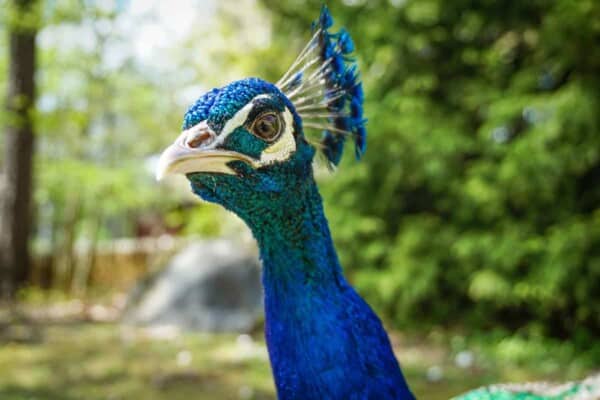
Why is Hera Important?

Why Did Aphrodite Hate Psyche?

7 Famous and Important Mortals in Greek Mythology

17 Hera Facts: From the Trojan War to a Peacock Chariot
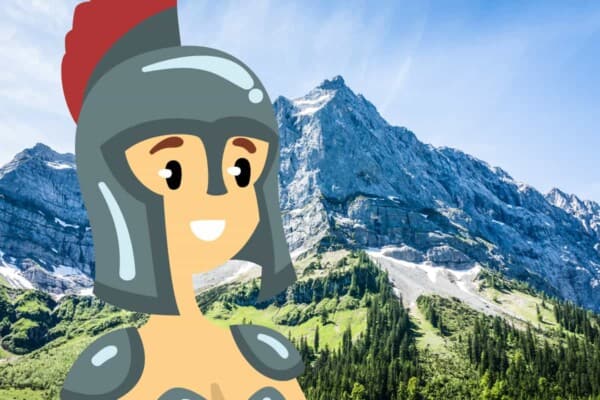
Did Athena Have Children?

9 Best Greek Mythology Movies: What are They?
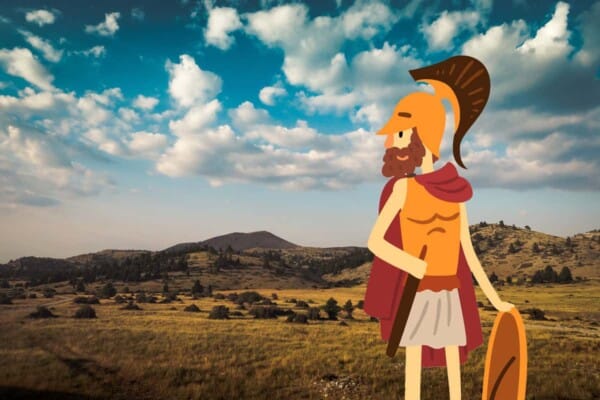
Why is Ares Important?
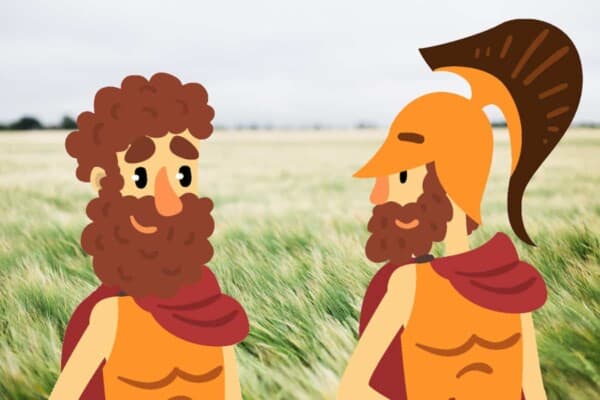
Odysseus and Achilles: What is the Difference?
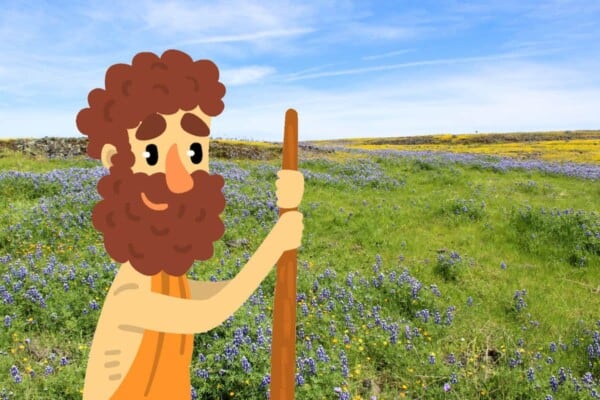
23 Interesting Facts About Orpheus: Musician and Cult Founder
Perseus constellation: Facts, location and myth
Perseus is one of Ptolemy's ancient constellations.

- Where and when can you see Perseus?
Perseus observing targets
The perseid meteor shower, perseus mythology.
- Perseus constellation FAQs
Additional resources
Perseus is the 24th largest constellation in the night sky and is visible across the Northern Hemisphere and parts of the Southern Hemisphere.
It has an area of approximately 615 square degrees, according to Constellation Guide . It is one of the 48 constellations cataloged by the 2nd-century astronomer Ptolemy, and it is named after the mythological Greek hero Perseus, who beheaded Medusa.
Perseus is best known as the radiant of August's Perseid meteor shower, one of the most prolific meteor showers of the year, as well as the variable star Algol, also known as the Demon Star. Algol fluctuates in brightness, appearing to "wink" in the night sky — this occurs when its two binary components eclipse one another.
Related: Night Sky: What you can see tonight (maps)
Where the Perseus constellation and when can you see it?
Perseus is located in the northern sky and is visible to most locations in the Northern Hemisphere and even some in the Southern Hemisphere.
In the Northern Hemisphere, from about 40 degrees latitude and above, the constellation is visible year-round, never setting below the horizon. Further south, it is most visible in the fall and winter, according to EarthSky , when the constellation reaches its highest point in the night sky (for the Northern Hemisphere). It has a right ascension of about four hours and a declination of 40 degrees North .
Because Perseus' stars are not so bright, the constellation is most easily spotted by looking for its neighbor, Cassiopeia , which has an easy-to-spot zig-zag shape that resembles an M or W, depending on how the constellation is oriented. If it's an M, Perseus will be below and to the right of the letter. If it's a W, it will be below and to the left. Perseus' most distinguishing feature is a curve of stars called the Segment of Perseus, which can be spotted by following the line from Cassiopeia's center star to either the bottom left star of the W or the top right star of the M, again depending on orientation.

Double Cluster The Milky Way runs through Perseus, which makes the constellation a good target for stargazing — there are a number of deep-sky objects to observe here. If you're in the market for some stargazing equipment, check out our guides to the best telescopes and binoculars .
Jargon buster
Magnitude : An object's magnitude is a measure of how bright an object appears from Earth . Brightness is measured on a numbered scale, with lower numbers being brighter than higher numbers. And it even goes negative!
Right ascension (RA): Right ascension is the sky's equivalent to longitude on Earth, and it helps astronomers locate celestial objects. It covers the east-west direction and is measured in hours, minutes and seconds.
Declination (Dec): Declination also helps astronomers locate celestial objects in the sky—it is akin to latitude on Earth. It marks how high an object will rise in the sky, covering the north-south direction in units of degrees, arcminutes and arcseconds (60 arcseconds in an arcmin, 60 arcmins in a degree).
Double Cluster

Magnitude : 4.3
Approximate distance from Earth: 7,600 and 6,800 light-years (NGC 844 and NGC 869, respectively)
Location: 2h 20m (right ascension), +57°08' (declination)
The Double Cluster comprises two open clusters , NG869 and NG844, of more than 300 supergiant stars each. The two celestial objects are fairly bright and can be seen through binoculars, according to Constellation Guide . Though they appear side by side, they're actually 800 light-years apart.
NGC 1333

Magnitude : 5.6
Approximate distance from Earth: 960 light-years
Location: 3h 29m 11s (right ascension), +31°18'36" (declination)
NGC 133 is a nebula within the Perseus Molecular Cloud, a region of gas and dust filled with young stars, according to NASA . More specifically, it's a reflection nebula, which means its dust clouds reflect the light of nearby stars.
Little Dumbbell Nebula (Messier 76)
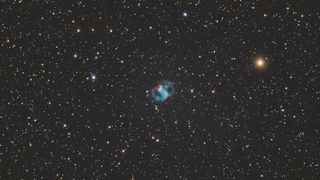
Magnitude : 10.1
Approximate distance from Earth: 2,500 light-years
Location: 1h 45m 24s (right ascension), +51°34'31" (declination)
Messier 76, also known as the Little Dumbbell Nebula, is, in fact, a nebula that looks like a little dumbbell—it's likely two nebulas with connecting components . The nebula is a planetary nebula, which means its clouds of dust and gas formed around a dying star.
NGC 1260
Magnitude : 14.2
Approximate distance from Earth: 240 million light-years
Location: 13h 17m 22s (right ascension), +41°24'19" (declination)
This lenticular galaxy was the site of supernova SN 2006gy, which, per NASA , was the brightest supernova ever discovered when it was first spotted in 2006.
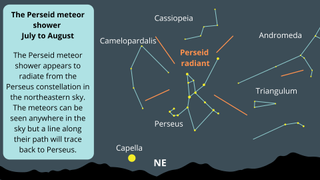
Though the Perseid meteor shower 's true origins are the debris trail of Comet 109P/Swift-Tuttle, the meteors appear to radiate from the Perseus constellation. The Perseids run from July 14 through Sept. 1, with a peak between Aug. 11 and 13. During the peak, you might be able to see up to 100 meteors per hour as they zip across the sky at 37 miles per second. The meteor shower is also known for producing fireballs, which are exceptionally bright meteors.
Perseus was a Greek hero, a demigod born of Zeus and Danae. According to GreekMythology.com , Perseus was tasked by the Greek king Polydectes to fetch the head of Medusa, the only mortal Gorgon. The gorgons were a trio of sisters with snakes for hair, whose gaze turned men to stone. Polydectes gave Perseus this task with the hope it would kill him, allowing Polydectes to forcibly marry Danae, who had rejected his advances.
As Perseus set out on his journey, he was graced by the goddess Athena and the god Hermes, who instructed him to find the Graeae, three other sisters of the Gorgons. By blackmailing the Graeae, Perseus learned the location of the Gorgons and successfully slayed Medusa by beheading her. The shape of the constellation Perseus represents the hero holding her head. Returning home, Perseus discovered Polydectes' ploy and used the head of Medusa to turn him to stone.
The legend has many tie-ins to Perseus' neighboring constellations Andromeda, Cepheus, Cassiopeia, Cetus and Pegasus. On his journey home after slaying Medusa, Perseus saved Andromeda, the daughter of Cassiopeia and Cephus, from being sacrificed to the sea monster Cetus. He later married Andromeda, and the two constellations named for the pair are next to each other in the sky. Perseus is also involved with the origin story of Pegasus, the winged horse — Pegasus emerged from Medusa's body after Perseus beheaded her.
Perseus constellation FAQs answered by an expert
We asked Mike Reed, an astronomer and a distinguished professor in the Department of Physics, Astronomy and Materials at Missouri State University, a few frequently asked questions about the Perseus constellation.

Distinguished Professor in the Department of Physics, Astronomy and Materials at Missouri State University
Where is the Perseus constellation?
In the sky, of course! Right now [early May 2023], it sets quite early, so in the evening, it is in the northwest. Roughly between Venus (this week, but not after) and the North Pole. It is pretty much set (below the horizon) by 10 p.m.
How can I find the Perseus constellation?
If you can see the Little Dipper, then the portion nearest the bowl points toward it. Or, if you know the W of Cassiopeia, it is roughly behind the W.
How many stars are in the Perseus constellation?
That is a very difficult question. It varies a lot depending on how dark your skies are and if you are just using your eyes or if you have binoculars or a telescope. It is in the plane of our galaxy, the Milky Way, so Hubble or James Webb space telescopes would see billions of stars. The main 'shape' of the constellation has about 10 stars, but at a dark site, you should be able to see 20 to 30 stars.
See a visualization of the giant wave rippling through the Perseus galaxy cluster, courtesy of NASA's Goddard Spaceflight Center . Learn about the myth of Perseus in this video by the Lowell Observatory. Watch the Perseid meteor shower from Joshua Tree National Park, as filmed by The Guardian .
Bibliography
Ford, D. The Constellation Perseus. In the Sky. Retrieved May 19, 2023, from https://in-the-sky.org/data/constellation.php?id=64
Mcclure, B. and Byrd, D. Cassiopeia and Perseus on October evenings. Earth Sky. Retrieved May 19, 2023, from https://earthsky.org/constellations/cassiopeia-and-perseus-in-northeast-on-october-evenings/
Messier 76. NASA. Retrieved May 19, 2023, from https://www.nasa.gov/feature/goddard/2018/messier-76
NGC 1333. NASA Hubblesite. Retrieved May 19, 2023, from https://hubblesite.org/contents/media/images/2023/012/01GWQFKJJE8VR2XVC09G43E9FR
Perseids. NASA. Retrieved May 19, 2023, from https://solarsystem.nasa.gov/asteroids-comets-and-meteors/meteors-and-meteorites/perseids/in-depth/
Perseus. Britannica. Retrieved May 19, 2023, from https://www.britannica.com/place/Perseus-constellation
Perseus Constellation. Constellation Guide. Retrieved May 19, 2023, from https://www.constellation-guide.com/constellation-list/perseus-constellation/
Perseus: The Slayer of Medusa. Greek Mythology. Retrieved May 19, 2023, from https://www.greekmythology.com/Myths/Heroes/Perseus/perseus.html
The Brightest Supernova Ever. NASA. Retrieved May 19, 2023, from https://science.nasa.gov/science-news/science-at-nasa/2007/07may_bigsupernova
Join our Space Forums to keep talking space on the latest missions, night sky and more! And if you have a news tip, correction or comment, let us know at: [email protected].
Get the Space.com Newsletter
Breaking space news, the latest updates on rocket launches, skywatching events and more!

Space.com contributing writer Stefanie Waldek is a self-taught space nerd and aviation geek who is passionate about all things spaceflight and astronomy. With a background in travel and design journalism, as well as a Bachelor of Arts degree from New York University, she specializes in the budding space tourism industry and Earth-based astrotourism. In her free time, you can find her watching rocket launches or looking up at the stars, wondering what is out there. Learn more about her work at www.stefaniewaldek.com .
Solar eclipse 2024: Live updates
Celestron SkyMaster Pro 20x80 review
Citizen scientists spot more than 1,000 new asteroids in old Hubble Telescope photos
Most Popular
- 2 Giant gamma-ray flare from 'recently deceased' magnetar lights up Cigar Galaxy
- 3 Earth got hammered by cosmic rays 41,000 years ago due to a weak magnetic field
- 4 Mirrors in space could boost solar power production on Earth. Here's how.
- 5 NASA ends CloudSat Earth-observing mission after 18 years
- Corrections
How Did Perseus Kill Medusa?
Perseus is the great hero of Greek mythology who famously slayed the terrifying Gorgon Medusa. But how on earth did he do it?

Perseus was the great hero of Greek mythology who slayed the Gorgon Medusa . She was a terrifying monster with curling snakes for hair, who could turn any living creature to stone with just a single look. Within her mysterious home, Medusa was guarded by her two immortal sisters, who were both also Gorgons . After travelling far and wide to find Medusa in her hidden lair, Perseus was able to slay the monster, chopping off her head and keeping it as a weapon to use against anyone who dared to cross him. But how did he achieve this seemingly impossible feat, and did anyone help him along the way?
Perseus Used His Skills in Bravery and Ingenuity

Let’s be honest – Perseus was not the most powerful hero of Greek mythology. He did not have the brute strength of Heracles , nor the incredible archery skills of Apollo . He was also young, naïve, and inexperienced. But what he lacked in physical strength, he made up for in loyalty, intelligence and ingenuity. The child of Zeus and the mortal woman Danae , Perseus was a demigod with many friends and allies. He was fiercely protective of his beautiful mother, who had many suitors. One of these suitors (who Perseus didn’t like very much), King Polydectes, asked Perseus to bring him the head of Medusa. Perseus rose to the challenge, even though he had no idea what he was doing. It was through his quick-smart intelligence that he was able to kill Medusa, but he could not have done it without a little help.
Perseus Had Help from the Gods (and Others)

When Perseus was tasked with killing Medusa, several of the gods stepped in to help their family member in his hour of need. The first to step up was the goddess Athena , who led him to the three Graeae, a group of sisters who shared one eye and one tooth. Perseus snatched away the sisters’ eye when they were passing it between one another, and promised to return it if they told him how to find Medusa. The Graeae reluctantly told him to go to the garden of the Hesperides , a group of nymphs. The Hesperides were waiting there with a series of very useful gifts from the gods. Let’s take a look through them below.
Hades’ Invisibility Helmet

Get the latest articles delivered to your inbox
Please check your inbox to activate your subscription.
Hades lent Perseus his amazing helmet, which was not just for protection – it could also render any wearer completely invisible. This meant Perseus could sneak into Medusa’s lair unseen by Medusa or her horrible sisters, and sneak back out again once the ghastly deed was done.
Athena’s Shiny Shield

Another very useful tool was Athena’s polished, mirrored shield. With it, Perseus was able to find exactly where Medusa was hiding, without actually having to look her in the eye. This trick meant he could slay Medusa by looking only in the reflection, thus achieving the seemingly impossible.
Zeus’s Sword

Zeus, the almighty king of all gods was Perseus’s father, so it seems logical that he would help his own son out in a desperate time of need. Zeus gave Perseus his trusty sword, which was so long and sharp, he was able to slay Medusa with just a single stroke. He then put her head in a knapsack and scurried away as quickly as he could.
Hermes’ Winged Sandals
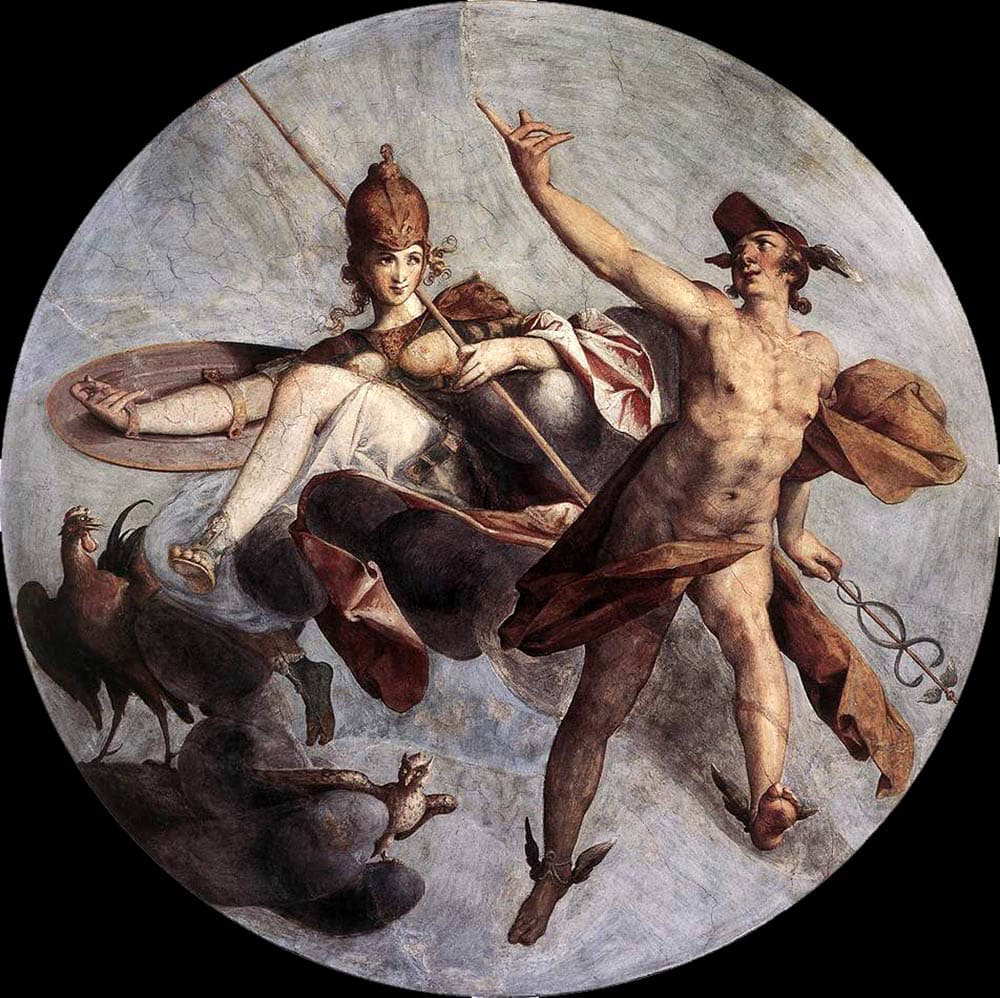
Of course, Perseus needed help to escape in a hurry from Medusa’s Gorgon sisters, so Hermes, the messenger to the gods, gave Perseus his winged sandals so he could fly away as fast as the wind. On his way home, Perseus rescued the beautiful Princess Andromeda , before returning home to turn King Polydectes into stone so he would leave his mother alone. Not bad for a day’s work!

The Ancient Gorgon Medusa: 9 Terrifying Facts

By Rosie Lesso MA Contemporary Art Theory, BA Fine Art Rosie is a contributing writer and artist based in Scotland. She has produced writing for a wide range of arts organizations including Tate Modern, The National Galleries of Scotland, Art Monthly, and Scottish Art News, with a focus on modern and contemporary art. She holds an MA in Contemporary Art Theory from the University of Edinburgh and a BA in Fine Art from Edinburgh College of Art. Previously she has worked in both curatorial and educational roles, discovering how stories and history can really enrich our experience of art.

Frequently Read Together

Medusa’s Head: The Gorgon Depicted in 6 Stunning Works

Who Were the Gorgons in Ancient Greek Mythology? (6 Facts)

Who Was Heracles in Greek Mythology?
share this!
April 23, 2024
This article has been reviewed according to Science X's editorial process and policies . Editors have highlighted the following attributes while ensuring the content's credibility:
fact-checked
trusted source
Hubble celebrates 34th anniversary with a look at the little dumbbell nebula
by Ray Villard, NASA
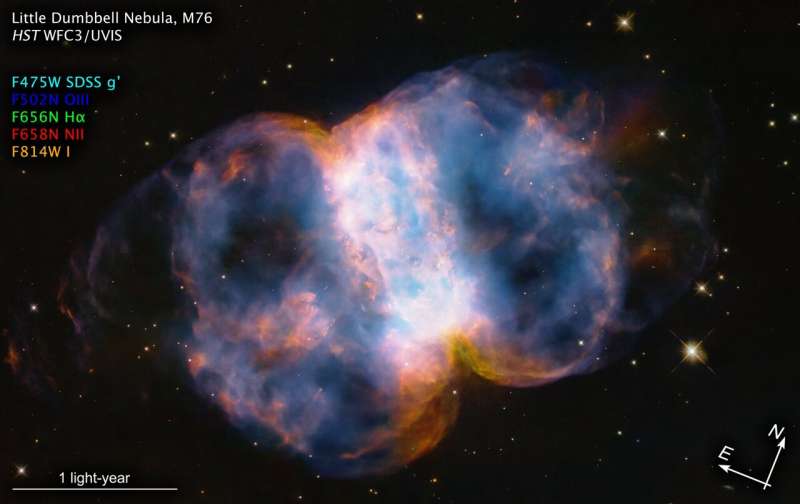
In celebration of the 34th anniversary of the launch of NASA's legendary Hubble Space Telescope on April 24, astronomers took a snapshot of the Little Dumbbell Nebula (also known as Messier 76, M76, or NGC 650/651) located 3,400 light-years away in the northern circumpolar constellation Perseus. The photogenic nebula is a favorite target of amateur astronomers.
M76 is classified as a planetary nebula , an expanding shell of glowing gases that were ejected from a dying red giant star. The star eventually collapses into an ultra-dense and hot white dwarf. A planetary nebula is unrelated to planets but has that name because astronomers in the 1700s using low-power telescopes thought this type of object resembled a planet.
M76 is composed of a ring, seen edge-on as the central bar structure, and two lobes on either opening of the ring. Before the star burned out, it ejected the ring of gas and dust. The ring was probably sculpted by the effects of the star that once had a binary companion star.
This sloughed-off material created a thick disk of dust and gas along the plane of the companion's orbit. The hypothetical companion star isn't seen in the Hubble image, so the central star could have later swallowed it. The disk would be forensic evidence for that stellar cannibalism.
The primary star is collapsing to form a white dwarf. It is one of the hottest stellar remnants known at a scorching 250,000 degrees Fahrenheit, 24 times our sun's surface temperature. The sizzling white dwarf can be seen as a pinpoint in the center of the nebula. A star visible in projection beneath it is not part of the nebula.
Pinched off by the disk, two lobes of hot gas are escaping from the top and bottom of the "belt," along the star's rotation axis that is perpendicular to the disk. They are being propelled by the hurricane-like outflow of material from the dying star, tearing across space at two million miles per hour.
That's fast enough to travel from Earth to the moon in a little over seven minutes! This torrential "stellar wind" is plowing into cooler, slower-moving gas that was ejected at an earlier stage in the star's life when it was a red giant. Ferocious ultraviolet radiation from the super-hot star is causing the gases to glow. The red color is from nitrogen, and the blue is from oxygen.
Given our solar system is 4.6 billion years old, the entire nebula is a flash in the pan by cosmological timekeeping. It will vanish in about 15,000 years.
Since its launch in 1990, Hubble has made 1.6 million observations of over 53,000 astronomical objects. To date, the Mikulski Archive for Space Telescopes at the Space Telescope Science Institute in Baltimore, Maryland, holds 184 terabytes of processed data that is science-ready for astronomers around the world to use for research and analysis.
Since 1990, 44,000 science papers have been published from Hubble observations. The space telescope is the most scientifically productive space astrophysics mission in NASA history. The demand for using Hubble is so high it is currently oversubscribed by a factor of six-to-one.
Most of Hubble's discoveries were not anticipated before launch, such as supermassive black holes , the atmospheres of exoplanets, gravitational lensing by dark matter , the presence of dark energy, and the abundance of planet formation among stars.
Hubble will continue research in those domains and capitalize on its unique ultraviolet-light capability on such topics as solar system phenomena, supernovae outbursts, the composition of exoplanet atmospheres, and dynamic emission from galaxies. Hubble investigations continue to benefit from its long baseline of observations of solar system objects, stellar variable phenomena, and other exotic astrophysics of the cosmos.
NASA's James Webb Space Telescope was designed to be complementary to Hubble, and not a substitute. Future Hubble research also will take advantage of the opportunity for synergies with Webb, which observes the universe in infrared light. The combined wavelength coverage of the two space telescopes expands on groundbreaking research in such areas as protostellar disks, exoplanet composition, unusual supernovae, cores of galaxies, and chemistry of the distant universe.
Provided by NASA
Explore further
Feedback to editors

Artificial intelligence helps scientists engineer plants to fight climate change
7 hours ago

Ultrasensitive photonic crystal detects single particles down to 50 nanometers

Scientists map soil RNA to fungal genomes to understand forest ecosystems
8 hours ago

Researchers show it's possible to teach old magnetic cilia new tricks

Mantle heat may have boosted Earth's crust 3 billion years ago

Study suggests that cells possess a hidden communication system
9 hours ago

Researcher finds that wood frogs evolved rapidly in response to road salts

Imaging technique shows new details of peptide structures

Cows' milk particles used for effective oral delivery of drugs

New research confirms plastic production is directly linked to plastic pollution
Relevant physicsforums posts, waves in space, 'devil' comet visible tonight 21.04.24.
4 hours ago
Solar Activity and Space Weather Update thread
Our beautiful universe - photos and videos, documenting the setup of my new telescope.
13 hours ago
What did I capture?
Apr 23, 2024
More from Astronomy and Astrophysics
Related Stories

Image: Hubble spots the Spider Galaxy
Mar 25, 2024

Hubble sees new star proclaiming its presence with cosmic light show

Image: Hubble spies eye in the sky
Nov 4, 2021

Image: Hubble views star nearing its end
Sep 2, 2019

Hubble views bright variable star V 372 Orionis and a smaller companion star
Jan 27, 2023

Webb reveals intricate details in the remains of a dying star
Aug 21, 2023
Recommended for you

International team detects eruption of mega-magnetic star in nearby galaxy
12 hours ago

Black hole 'traffic jams' discovered in galactic centers by astronomers

New evidence found for Planet 9

Observations explore globular cluster system in the galaxy NGC 4262

Star bars show universe's early galaxies evolved much faster than previously thought

Researchers detect a new molecule in space
Let us know if there is a problem with our content.
Use this form if you have come across a typo, inaccuracy or would like to send an edit request for the content on this page. For general inquiries, please use our contact form . For general feedback, use the public comments section below (please adhere to guidelines ).
Please select the most appropriate category to facilitate processing of your request
Thank you for taking time to provide your feedback to the editors.
Your feedback is important to us. However, we do not guarantee individual replies due to the high volume of messages.
E-mail the story
Your email address is used only to let the recipient know who sent the email. Neither your address nor the recipient's address will be used for any other purpose. The information you enter will appear in your e-mail message and is not retained by Phys.org in any form.
Newsletter sign up
Get weekly and/or daily updates delivered to your inbox. You can unsubscribe at any time and we'll never share your details to third parties.
More information Privacy policy
Donate and enjoy an ad-free experience
We keep our content available to everyone. Consider supporting Science X's mission by getting a premium account.
E-mail newsletter

IMAGES
VIDEO
COMMENTS
Perseus, bronze sculpture by Benvenuto Cellini, 1545-54; in the Loggia dei Lanzi, Florence. Perseus, in Greek mythology, the slayer of the Gorgon Medusa and the rescuer of Andromeda from a sea monster. Perseus was the son of Zeus and Danaë, the daughter of Acrisius of Argos. As an infant he was cast into the sea in a chest with his mother by ...
In Greek mythology, Perseus (US: / ˈ p ɜː r. s i. ə s /, UK: / ˈ p ɜː. sj uː s /; Greek: Περσεύς, translit. Perseús) is the legendary founder of the Perseid dynasty.He was, alongside Cadmus and Bellerophon, the greatest Greek hero and slayer of monsters before the days of Heracles. He beheaded the Gorgon Medusa for Polydectes and saved Andromeda from the sea monster Cetus.
Perseus was the son of Zeus, the king of the gods, and Danae, a mortal princess and daughter of the Argive king Acrisius. Danae's father was told by an oracle that he was destined to die at the hands of his grandson. Thus, he locked Danae up in a dungeon to prevent her from ever bearing a son. But Zeus visited Danae as a shower of gold dust ...
Definition. Perseus is one of the greatest and oldest pan - Hellenic heroes of Greek mythology. Perseus famously killed the dreaded Medusa, a Gorgon with snakes as hair and whose stare turned men to stone. Perseus also carried out the daring rescue of Princess Andromeda from a monstrous sea creature sent by the god Poseidon to terrorize the ...
Perseus, King of Mycenae. After causing the prophesized death of his grandfather Acrisius, Perseus was noted to be ashamed to take the kingdom for his own. Instead, he offered the kingdom of Argos to Megapenthes who was his uncle and the ruler of Tiryns. In exchange, Perseus would become the ruler of Tiryns.
Perseus was the son of Zeus, and the god of gods wanted to protect him on his quest. So Zeus and his brothers got together armor and weapons to help Perseus succeed against Medusa. Hades gave Perseus the helmet of invisibility, Hermes his winged sandals, Hephaestus a mighty sword, and Athena a reflective bronze shield.
Perseus' Early Life Perseus was the demigod offspring of the unusual union between Zeus and Danae: the supreme god came to the imprisoned princess of Argos in the form of a golden shower through a crack in the roof of her chamber. Afterward, locked in a wooden chest, both were thrown into the sea by Danae's father Acrisius, who had known from the oracle that he would eventually be killed ...
The Birth of Perseus. Like many of the great heroes of Greek mythology, Perseus was a son of Zeus. And, like many, he was born to a human mother. His mother Danaë was the daughter of Acrisius, the king of Argos. At the time, Argos was one of the most prosperous cities of Greece, situated on the fertile plain in a good strategic location.
Perseus (born c. 213/212 bc —died c. 165, Alba Fucens, near Rome [Italy]) was the last king of Macedonia (179-168), whose attempts to dominate Greece brought on the final defeat of Macedonia by the Romans, leading to annexation of the region. The elder son of King Philip V of Macedonia, Perseus commanded troops in his father's wars ...
Perseus ' life was a very interesting one, full of adventures. He was the son of the god Zeus and Danae. His reputation and character quickly turned him into a local hero of Argos (a place in Peloponese, Greece). Arcisius, Perseus ' grandfather, had asked an oracle if he would ever have any kids; the answer he got was shocking and led him to ...
Perseus. PERSEUS. Perseus, one of the most renowned of the legendary heroes of antiquity, was the son of Zeus and Danaë, daughter of Acrisius, king of Argos.. An oracle having foretold to Acrisius that a son of Danaë would be the cause of his death, he imprisoned her in a tower of brass in order to keep her secluded from the world. Zeus, however, descended through the roof of the tower in ...
The story of Perseus begins in the Greek kingdom of Argos, at a time when King Acrisius was on the throne; although he had lost half his kingdom to his brother Proetus, who now had a kingdom based around Tiryns. Acrisius was married to Eurydice, daughter of King Lacedaemon, and Eurydice would bear to Acrisius but one child, a daughter who was ...
Perseus, Athena and head of Medusa, Apulian red-figure krater C4th B.C., Museum of Fine Arts Boston PERSEUS was one of the most celebrated heroes of Greek mythology. He was the son of the Argive princess Danae who was locked away in a bronze chamber by her father Akrisios (Acrisius) who lived in fear of a prophecy that he would one day be killed by her son.
Perseus, being a fisherman, had no horses but pledged to bring the king the head of Medusa, the Gorgon, instead. Pollux readily accepted this commitment, as no man had ever returned alive from an encounter with a Gorgon. Pollux decided to keep Danae in the palace until Perseus returned with Medusa's head.
Perseus' Father. Zeus is the king of the gods in Greek mythology. He was the son of Cronus and Rhea and was born on the island of Crete. Zeus was known for his power and his thunderbolt, which he used to control the weather and strike down his enemies. Zeus was also associated with hospitality, oaths, and justice, and he was often depicted as ...
Hermes, god of travel, gave Perseus a pair of winged sandals. Athena, god of women, gave Perseus a reflective bronze shield, and Hephaestus, god of fire and the forge, gave Perseus a sword. Perseus Finds and Beheads Medusa. Using the gifts from the gods, Perseus locates and enters Medusa's cave. Perseus finds Medusa asleep inside her cave and ...
Perseus Was the Son of Zeus and Danae. Perseus was conceived under unlikely circumstances. His father was Greek god Zeus, and his mother was Danae, a beautiful mortal princess. Danae was the daughter of Acrisius, king of Argos. Unfortunately for Danae, Acrisius was a horrible, controlling father. When an oracle told Acrisius that his only ...
Perseus can count himself among the lot of ancient Greek personalities whose name will at least ring a few bells. As with many other heroes, he is most known for one big thing. Like Theseus, who is known for slaying the minotaur, and Bellerophon, who is known for riding Pegasus, Perseus is primarily known for slaying Medusa, the mortal Gorgon ...
Danae and the infant Perseus cast out to sea by Acrisius. Giorgio Ghis 1543. Abas, the son of Lynkeus and Hypermestra, followed the family tradition and had twin sons, Proitos and Akrisios. The twins fought continually, even while still within their mother's body, and continued their conflict as they grew up. Eventually Proitos left and started ...
Perseus - the son of Zeus and all round talented warrior who is comes to wield the head of Medusa. Andromeda - the daughter of Cepheus and Cassiopeia, she is said to be very beautiful and is a hapless victim in this story. Cepheus - the king of Joppa and quite a weak willed individual. Cassiopeia - She was the wife of Cepheus.
Perseus was a Greek hero, a demigod born of Zeus and Danae. ... With a background in travel and design journalism, as well as a Bachelor of Arts degree from New York University, she specializes in ...
Perseus Had Help from the Gods (and Others) When Perseus was tasked with killing Medusa, several of the gods stepped in to help their family member in his hour of need. The first to step up was the goddess Athena, who led him to the three Graeae, a group of sisters who shared one eye and one tooth. Perseus snatched away the sisters' eye when ...
In celebration of the 34th anniversary of the launch of NASA's legendary Hubble Space Telescope on April 24, astronomers took a snapshot of the Little Dumbbell Nebula (also known as Messier 76 ...